A little humor goes a long way.
What mall is this? I have no idea. Edit: It’s apparently at the Berkshire Mall in Wyomissing, Pennsylvania, which we’ve covered in the past.
Labelscar: The Retail History Blog
News and Views of Malls, Shopping Centers, and Retail Chains Past and Present
A little humor goes a long way.
What mall is this? I have no idea. Edit: It’s apparently at the Berkshire Mall in Wyomissing, Pennsylvania, which we’ve covered in the past.
 We round out our Rochester features with the region’s newest mall, Irondequoit Mall. Opened in 1990, Irondequoit Mall was located in Rochester’s northeast suburb of the same name, Irondequoit, a town of 50,000 residents located immediately northeast of the city. When it opened, Irondequoit Mall had three anchors: Sears, JCPenney, and Pittsburgh-based Kaufmann’s. The Kaufmann’s was originally slated to be Rochester-based department store Sibley’s, but May Company decided to consolidate their nameplates and ousted Sibley’s in favor of regional brand Kaufmann’s. This switch took place during Irondequoit Mall’s construction. (Is this correct? A couple sources say that Sibley’s acutally opened here very briefly.)
We round out our Rochester features with the region’s newest mall, Irondequoit Mall. Opened in 1990, Irondequoit Mall was located in Rochester’s northeast suburb of the same name, Irondequoit, a town of 50,000 residents located immediately northeast of the city. When it opened, Irondequoit Mall had three anchors: Sears, JCPenney, and Pittsburgh-based Kaufmann’s. The Kaufmann’s was originally slated to be Rochester-based department store Sibley’s, but May Company decided to consolidate their nameplates and ousted Sibley’s in favor of regional brand Kaufmann’s. This switch took place during Irondequoit Mall’s construction. (Is this correct? A couple sources say that Sibley’s acutally opened here very briefly.)
We round out our Rochester features with the region’s newest mall, Irondequoit Mall. Opened in 1990, Irondequoit Mall was located in Rochester’s northeast suburb of the same name, Irondequoit, a town of 50,000 residents located immediately northeast of the city.
When it opened, Irondequoit Mall had three anchors: Sears, JCPenney, and Pittsburgh-based Kaufmann’s. The Kaufmann’s was originally slated to be Rochester-based department store Sibley’s, but May Company decided to consolidate their nameplates and ousted Sibley’s in favor of regional brand Kaufmann’s. This switch took place during Irondequoit Mall’s construction. (Is this correct? A couple sources say that Sibley’s acutally opened here very briefly.)
Irondequoit Mall’s design was a modified U shape, with Kaufmann’s as the west anchor, JCPenney in the middle, and Sears on the north end. The mall was two level, had two main courts, and contained space for 125 stores. The food court was located on the upper level of the mall, in a court formed by the intersection of 3 hallways. JCPenney had the best access of any of the anchor stores, having two exits into the mall: one at center court, and one to a hallway leading directly to the food court. A scanned directory of the mall is located here.
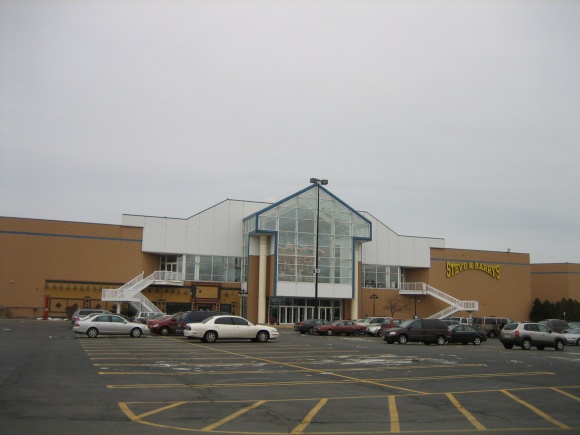 Irondequoit Mall was built by Rochester-based retail developer Wilmorite, the same firm that developed three other malls in the Rochester market: Greece Towne Mall in Greece (1967), Eastview Mall in Victor (1971), and Marketplace Mall in Henrietta (1982). Irondequoit Mall was built in 1990 to complete a geographic trapezoid of sorts consisting of malls around the perimiter of the Rochester area, with downtown stalwart Midtown Plaza at the apex.
Irondequoit Mall was built by Rochester-based retail developer Wilmorite, the same firm that developed three other malls in the Rochester market: Greece Towne Mall in Greece (1967), Eastview Mall in Victor (1971), and Marketplace Mall in Henrietta (1982). Irondequoit Mall was built in 1990 to complete a geographic trapezoid of sorts consisting of malls around the perimiter of the Rochester area, with downtown stalwart Midtown Plaza at the apex.
While only 2 miles from downtown Rochester, Irondequoit Mall was built with the intention to draw shoppers from middle and upper-middle suburban areas north and east of the city, like Irondequoit, Webster, East Rochester, Pittsford and Fairport. Instead, Irondequoit Mall failed and ultimately succumbed to an unintended set of circumstances. However, its story is interesting and still in progress, and definitely worth sharing.
Irondequoit Mall enjoyed early success in its first years and even embarked on an expansion in 1993, adding Rochester-based McCurdy’s as a fourth anchor. This store didn’t last very long, however, and was replaced with Bon Ton in 1994. May Company, which already owned the Kaufmann’s anchor in the mall, purchased the McCurdy’s chain and didn’t want to operate two stores in the same mall, so they divested McCurdy’s to Bon Ton.
The biggest changes for Irondequoit Mall came after 1995, and didn’t even occur there at all. That year, two other Rochester-area malls expanded dramatically. Eastview Mall, located 15 miles away in Victor, added two anchors and upscaled to become the Rochester area’s best mall. Greece Ridge Mall, located 7 miles away in Greece, was a new mall created that year by sewing together 2 smaller adjacent malls, Long Ridge Mall and Greece Towne Center. Ironically, both of these projects were Wilmorite’s, the same company that built Irondequoit Mall only 5 years earlier. The competition from these two expansions, combined with a perception of crime and dab of racism, would soon slide Irondequoit Mall into obsolescence.
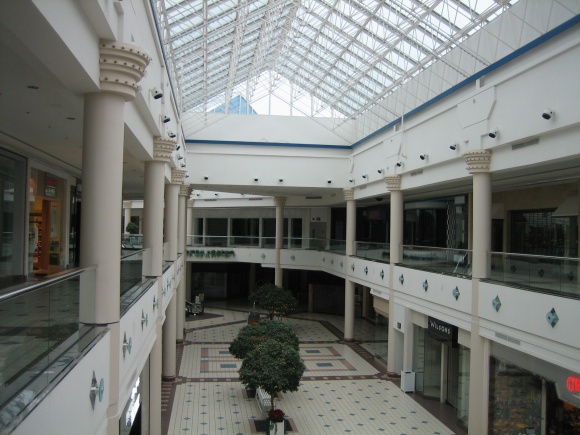 During the mid-90s, about the same time Eastview expanded and Greece Ridge opened, Rochester’s inner-city mall, Midtown Plaza, began to die. Shoppers who used to go downtown began to shift their preferences toward suburban malls, and Irondequoit Mall was the closest mall to most of the city of Rochester. Many residents of the city of Rochester, especially the area closest to Irondequoit Mall, are low income and minority. In typical ‘white flight’ fashion, the more affluent suburban shoppers Irondequoit Mall so desperately wished to court began to avoid the mall, citing a perception of crime that ironically wasn’t really there. A whisper campaign about the mall and its shoppers began among the sheltered, white suburbanites in eastern Monroe County, despite the fact that the perception of crime was mostly untrue, blown wildly out of proportion.
During the mid-90s, about the same time Eastview expanded and Greece Ridge opened, Rochester’s inner-city mall, Midtown Plaza, began to die. Shoppers who used to go downtown began to shift their preferences toward suburban malls, and Irondequoit Mall was the closest mall to most of the city of Rochester. Many residents of the city of Rochester, especially the area closest to Irondequoit Mall, are low income and minority. In typical ‘white flight’ fashion, the more affluent suburban shoppers Irondequoit Mall so desperately wished to court began to avoid the mall, citing a perception of crime that ironically wasn’t really there. A whisper campaign about the mall and its shoppers began among the sheltered, white suburbanites in eastern Monroe County, despite the fact that the perception of crime was mostly untrue, blown wildly out of proportion.
With the writing on the wall, Irondequoit Mall quickly began to lose retailers. After the Eastview expansion was complete, shoppers in Fairport, Pittsford, and East Rochester had no reason to go up to Irondequoit at all. Eastview was much better, and much closer to them. In fact, Eastview quickly became super-regional, drawing shoppers from not only its home trade area, but from beyond the region as well. Other Rochester malls retained shoppers for other reasons. Greece Ridge held on mostly due to largesse and a unique mix of big box and traditional anchors, and Marketplace Mall’s success hinged on its location near Rochester’s undergraduate population of over 50,000 students.
By 2000, Irondequoit Mall was only 10 years old and already in dire straits. The beautiful, modern, glassy two-level mall began to lose national chain stores, first at a trickle and then as a flood.
The first anchor to leave the mall was JCPenney in 2003, but by this time the mall’s staggering 20 percent occupancy rate made it already a lost cause.
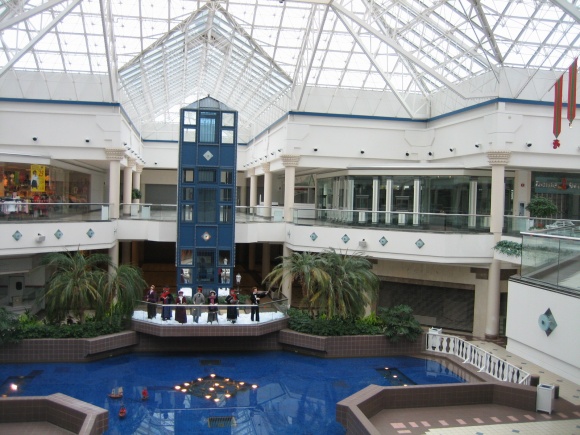 Rumors even began to surface about a new mall to be constructed in Webster, the next town east of Irondequoit. This would have certainly been a terrible idea, but I guess the idea was to keep the minority riff-raff from the city of Rochester out of the mix in order to retain wealthy white shoppers. Not cool, but at least it never happened.
Rumors even began to surface about a new mall to be constructed in Webster, the next town east of Irondequoit. This would have certainly been a terrible idea, but I guess the idea was to keep the minority riff-raff from the city of Rochester out of the mix in order to retain wealthy white shoppers. Not cool, but at least it never happened.
In 2005, Wilmorite finally threw in the towel on their dwindling investment and put Irondequoit Mall up for sale. Their divestiture of Irondequoit was tantamount to an admission of failure, as their own efforts expanding Eastview and building Greece Ridge were probably the biggest reasons Irondequoit failed, combined with changing shopper demographics and a misinformed perception of crime due to racism.
That same year, Adam Bersin, a Syracuse developer, purchased Irondequoit Mall for just $5 million and a wheelbarrow of tax incentives from the town of Irondequoit, whose coffers had been dry ever since the mall went downhill. Bersin re-christened the mall with a new name, Medley Centre, and new promises, along with a new logo indicating the mall was “New York’s Shopping Spree”.
One of Bersin’s first changes was to install an anchor to the former JCPenney space, which he did by attracting fast-expanding fly-by-night retailer Steve and Barrys, a warehouse of cut-rate, low-quality clothing, which opened in 2005.
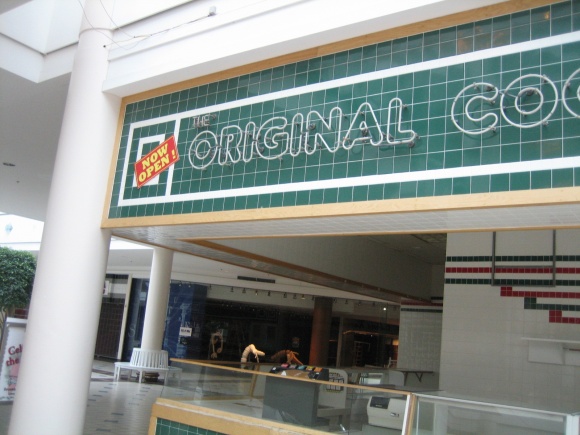 In 2006, Bersin brought a large-scale Halloween event to Medley Centre, which attracted a healthy crowd and filled an entire wing of the mall, but who knows how many of them stayed to shop in the mostly empty mall. On October 8, 2006, Target opened outside in the mall’s parking lot, but it isn’t clear if Target helped the mall or just ciphoned from it, driving it even more into the ground. If Target had opened IN the mall where Steve and Barry’s was, using the former JCPenney anchor, it might have helped more. That fall, another anchor change occurred as Kaufmann’s became Macy’s when Macy’s parent, Federated, purchased Kaufmann’s parent, May, and consolidated all of the regional nameplates under the Macy’s banner.
In 2006, Bersin brought a large-scale Halloween event to Medley Centre, which attracted a healthy crowd and filled an entire wing of the mall, but who knows how many of them stayed to shop in the mostly empty mall. On October 8, 2006, Target opened outside in the mall’s parking lot, but it isn’t clear if Target helped the mall or just ciphoned from it, driving it even more into the ground. If Target had opened IN the mall where Steve and Barry’s was, using the former JCPenney anchor, it might have helped more. That fall, another anchor change occurred as Kaufmann’s became Macy’s when Macy’s parent, Federated, purchased Kaufmann’s parent, May, and consolidated all of the regional nameplates under the Macy’s banner.
Despite the small victories in landing Target and Steve and Barry’s, Bersin’s tenure as Medley Centre’s owner wasn’t very successful overall. Mall directories were woefully out of date, still displaying advertisements that were several years old and listing stores that had long departed; however, some progress occurred in the right direction, as the mall’s upkeep became visible through rebuilt entrances, healthy plants, cosmetic repairs, and general maintenance. Bersin also expanded the MedleyKids soft play area, so that it encompassed a huge space in the mall’s western court, underneath the food court.
Mall occupancy, however, remained woefully low. Most of the chain stores left, leaving a weird, eclectic mix of mom-and-pop stores and non-retail entities. Some of the parcels in the mall were given over to a dog obedience school, an english-as-a-second-language institute, a summer camp, and a town meeting space. One former store became home to a model train track, and another store was used as a combination travel agency and security guard training school. So, after you were done riding the HO-scale rails, you could be sure you were extremely safe while planning your trip to Cancun.
Along with the cosmetic updates at Medley Centre, Bersin made a controversial decision regarding the mall’s patrons, issuing a divisive edict regarding who was welcome there. Signs were posted throughout the mall, especially near the food court area, indicating that cards and chess games were prohibited, which was considered a low blow by many. I saw the signs when I visited the mall in December 2007, and was puzzled by them, especially considering there wasn’t anybody in the large food court area at all.
Here’s a photo of the rules. These were posted throughout the mall.
Ever since the mall opened, the food court had been a gathering place for local seniors, who regularly got breakfast and loitered in the mall, using it as a social gathering place to chat and play games. Bersin’s new rules removed them in order to establish a “family-friendly” atmosphere in the mall. They asserted the group of seniors, who played games and socialized, actively discouraged others from being there, which I find patently ridiculous. The new rules created deep-seated resentment from a large customer base, and was probably not the greatest decision. Who’s to say these seniors didn’t also shop at the mall? I’m sure many patronized at least Sears and Bon Ton? Seniors are a strange group to alienate, considering their loyalty and purchasing power, and the grapevine effect probably alienated more people than Bersin expected. Also, what if some of the food court vendors relied upon this group for breakfast or lunch revenues?
In addition to alienating seniors, mall security also became more vigilant against groups of kids in the mall, banning those who frequently loitered and were seen as a nuisance to regular shoppers. Mall walkers were still welcome, because they weren’t seen as intrusive to shoppers. What shoppers? Many saw these measures as extreme and unnecessary, and questioned whether they would further harm the mall rather than help it.
I agree with policing groups of minors who get out of hand, and this is a big problem at every mall, but ousting seniors from their regular breakfast gathering spot seems brutal and short-sighted. Seeing a completely empty food court and empty corridors is certainly less inviting than an active mall with people conversing and enjoying each other, even if they aren’t necessarily buying. To me, an active mall is a continuous feedback loop of success, and welcoming benign groups such as seniors promotes more activity. Rather than discouraging people from coming, management should have become more creative and proactive in seeking better marketing solutions to reach these people. At the very least, the presence of people in a mall makes it more welcoming and encourages visiting longer, while an empty mall is creepy and alarming. Malls should tread lightly on restricting access to benign social gathering, and realize that their role as a social place mostly helps, rather than harms.
Check out these ads in the mall that I photographed in December 2007. Keep in mind the mall had changed its name in 2005 from Irondequoit Mall to Medley Centre.
In 2007, Medley Centre met even more challenges, with the departure of both anchor Bon Ton and also Adam Bersin as the mall’s owner. Bersin tacitly gave up on Medley Centre, and sold it to Scott Congel, a former developer from Syracuse’s Pyramid Companies, in March 2007. Congel paid $4.7 million for the mall, slightly less than the $5.4 million Bersin paid just two years prior. Pyramid is the Syracuse counterpart to Rochester’s Wilmorite, and has also developed malls throughout the northeast. Bersin initially remained to manage the property during the transitional phase of changing ownership, but has since left the project completely.
At first, Congel remained tight-lipped about his plans, or lack thereof, for Medley Centre, until rumors surfaced in April 2008 of a deal between the mall and Regal Cinemas. A Memorandum of Lease was filed with Monroe County on April 22 of that year, citing a lease agreement between the mall and Regal to develop a 66,000 square-foot 16-auditorium theater complex on two levels, using the former Bon Ton space. The document also leaked Congel’s longer-term plans for the site, indicating a mixed-use project consisting of retail, residential, restaurant, entertainment, office space, and other venues.
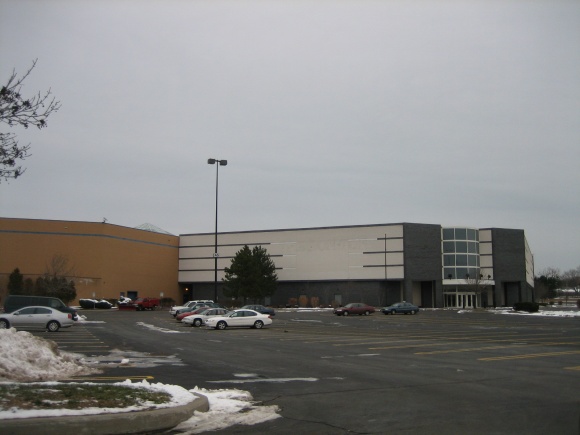 Congel’s plans were initially vague, though, and the vaguery led to questions. Would Congel demolish the mall as part of his master plan? What was the scope of the project? How did he expect to succeed with a mixed-use development in a mall that was the newest in town and already failed? Meanwhile, Steve and Barry’s departed the mall in May 2008, likely a decision made following a March 2008 visit by Steve and Barry themselves, who must have said something like “WTF? Why do we have a store here?” They promptly moved to a “better” location at a nearby strip mall, West Gates Shopping Center. Shortly thereafter, though, the entire Steve and Barry’s chain went out of business, so in the end their early departure was moot concerning the mall’s success.
Congel’s plans were initially vague, though, and the vaguery led to questions. Would Congel demolish the mall as part of his master plan? What was the scope of the project? How did he expect to succeed with a mixed-use development in a mall that was the newest in town and already failed? Meanwhile, Steve and Barry’s departed the mall in May 2008, likely a decision made following a March 2008 visit by Steve and Barry themselves, who must have said something like “WTF? Why do we have a store here?” They promptly moved to a “better” location at a nearby strip mall, West Gates Shopping Center. Shortly thereafter, though, the entire Steve and Barry’s chain went out of business, so in the end their early departure was moot concerning the mall’s success.
In November 2008, Congel finally released more information regarding his plans to redevelop Medley Centre. The aforementioned Regal Cinemas would go where the former Bon Ton store was, along with 194,000 square feet of office space, a 421-room, 30-story hotel as the centerpiece of the development (wow!), 330 residential units, and 1.2 million square feet of retail and restaurant space.
In her response to the plan, Irondequoit Town Supervisor Mary Ellen Heyman called it “sketchy”, which we couldn’t have said any better. Why would 1.2 million square feet of retail and restaurant space succeed here? The problem this development doesn’t address is that Rochester massively overbuilt its retail options. The region isn’t in the Sun Belt – it’s not growing that fast, and the problem wasn’t with the structure. Built in 1990, it’s a bright, glassy, modern looking mall and one of the newest in the state of New York. Also, I’m not sure a 30-story hotel is needed here either, as most of the area’s hotels are clustered elsewhere, logically clustered near major businesses and the universities. Residential might work, but I really think that the developer is a little wide-eyed at the possibilites for the site, and should consider down-scaling to a neighborhood center rather than constructing something super-regional, which will ultimately just ciphon from other businesses in the area. On the taxpayers’ dime, no less.
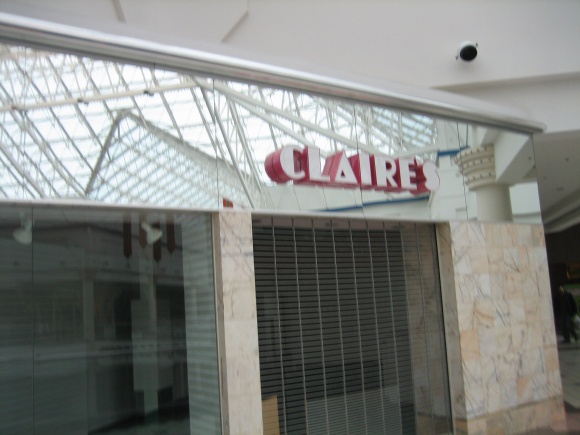 Nonetheless, in March 2009, Congel received approval for tax abatement from Monroe County, which included the consent of the Town of Irondequoit and the East Irondequoit School District. After clearing regulatory hurdles, including changing the zoning for the site, Congel kicked the remaining 20 or so tenants out of the mall in January 2009, and sealed the mall. This left only Macy’s and Sears as the remaining tenants, and they remain open as of December 2010. The name of the mall was also changed in 2009 to signify its rebirth, from Medley Centre to Lake Ridge Centre. Apparently third time’s a charm.
Nonetheless, in March 2009, Congel received approval for tax abatement from Monroe County, which included the consent of the Town of Irondequoit and the East Irondequoit School District. After clearing regulatory hurdles, including changing the zoning for the site, Congel kicked the remaining 20 or so tenants out of the mall in January 2009, and sealed the mall. This left only Macy’s and Sears as the remaining tenants, and they remain open as of December 2010. The name of the mall was also changed in 2009 to signify its rebirth, from Medley Centre to Lake Ridge Centre. Apparently third time’s a charm.
With the redevelopment project ready to begin, the only problem became obtaining financing. Unfortunately, with the economic slowdown of recent, this proved to be extremely difficult, especially as banks are still relatively new to financing mixed-use developments and don’t quite have the process or metrics down to a science like they had for traditional businesses, like enclosed shopping malls.
Meanwhile, in November 2009, the Rochester Broadway Theatre League (RBTL) chose the mall’s redevelopment as a possible site for a new, 3,000 seat Broadway-style theatre. The new theater would have some on-street parking and a two-level parking garage adjacent to it, and would also include 6,000 square feet of rehearsal or meeting space and a smaller event space for up to 200 guests. Shortly after being elected, Irondequoit’s Supervisor-Elect Mary Joyce D’Aurizio initially vocalized dissent for the theatre’s location, hoping that it went to downtown Rochester in order to help that area sustain its own renaissance rather than locating it in the suburbs. However, within a few months she changed her tune, recanted those thoughts and expressed support of it being located in Irondequoit. Flip flop.
In April 2010, nothing was going on at the site, which at this point was becoming an eyesore, and Congel met with D’Aurizio to chat with her about repositioning some of the tenants in order to reduce remodeling costs, which will in turn make it easier to acquire financing to begin the project. Congel also had to reapply for demolition and other permits that he already purchased but had lapsed. Oops, but fair enough.
 Then, during Summer 2010, the only major development regarding Lake Ridge Centre was a blow for it: the RBTL theater was awarded to the former Midtown Plaza in downtown Rochester. This was a boon for that development, though, and for downtown Rochester.
Then, during Summer 2010, the only major development regarding Lake Ridge Centre was a blow for it: the RBTL theater was awarded to the former Midtown Plaza in downtown Rochester. This was a boon for that development, though, and for downtown Rochester.
As of December 2010, no work has yet begun on the redevelopment, and the mall sits empty except for Sears and Macy’s, who are still open for business as usual. If that wasn’t bad enough, the only other recent news is also ominous. A lawsuit filed in 2009 by the snow removal contract company the mall hired to remove its snow (and Rochester gets a ton of snow) was settled a few days ago for almost $50,000, because the mall refused to pay the company. Oops again.
Ultimately, this development is a terrible gamble and a lose-lose situation for metro Rochester. I don’t wish failure on many businesses, and I don’t wish failure on this one, either, but it’s either greediness or short-sightedness, or both, that leads otherwise intelligent government officials to give tax breaks to projects that carry a lot of risk and will add nothing to the region’s economic development. If Congel fails, and Lake Ridge Center fails, it’ll just be another publicly-financed eyesore on the landscape.
Even if Congel succeeds, and the development is ultimately a success, it will only steal business from elsewhere in the region. The retail development will cause a dearth at other malls, the hotel will take business from a hotel somewhere else, and the other businesses will steal from businesses elsewhere in town. Greater Rochester doesn’t need more retail. There are plenty of underused and dead shopping plazas littered across town, and Midtown Plaza, a large mall downtown, closed in 2008 after over 40 years in business. Rochester isn’t growing by any significant measure, so any new business is just going to steal from existing development. So what gives? The only people to benefit from this development are those involved in the development itself, and possibly the Town of Irondequoit if it can improve their tax base and add some jobs there. From a big-picture regional planning standpoint, it is only going to harm Rochester as a whole.
We visited Medley Centre in December 2007. Steve and Barry’s was still in business there, and the mall had about 25/125 stores, feeling very empty. Some interesting highlights included the fully-intact signage on many dead stores, and the McCurdy’s labelscar that appeared after the Bon Ton sign was removed. Check it out, and feel free to leave your own comments and experiences.
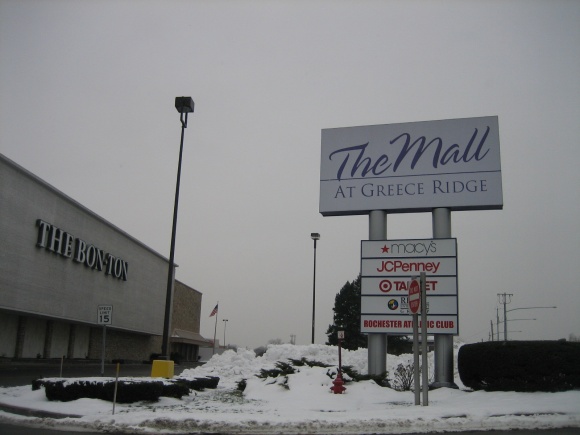 With 1.4 million square feet of retail space, The Mall at Greece Ridge is the largest shopping center in metro Rochester. Located in the suburb of Greece, about 8 miles northwest of downtown Rochester, Greece Ridge is a sprawling, Z-shaped one level mall, with 140 stores and restaurants and space for 16 anchors. Greece Ridge’s trajectory from a single Sears store to two separate enclosed malls, and finally to the monster it is today, is an interesting and unique story worth sharing.
With 1.4 million square feet of retail space, The Mall at Greece Ridge is the largest shopping center in metro Rochester. Located in the suburb of Greece, about 8 miles northwest of downtown Rochester, Greece Ridge is a sprawling, Z-shaped one level mall, with 140 stores and restaurants and space for 16 anchors. Greece Ridge’s trajectory from a single Sears store to two separate enclosed malls, and finally to the monster it is today, is an interesting and unique story worth sharing.
With 1.4 million square feet of retail space, The Mall at Greece Ridge is the largest shopping center in metro Rochester. Located in the suburb of Greece, about 8 miles northwest of downtown Rochester, Greece Ridge is a sprawling, Z-shaped one level mall, with 140 stores and restaurants and space for 16 anchors. Greece Ridge’s trajectory, from a two separate enclosed malls to the monster it is today, is an interesting and unique story worth sharing.
In 1966, Rochester-based developer Wilmorite began construction on the first of its four enclosed regional malls in the area. Called Greece Towne Mall, it opened May 1, 1967, and was the second enclosed mall in all of greater Rochester after Midtown Plaza, which opened downtown in 1962. It was located at the corner of NY 104 (Ridge Road) and Long Pond Road, in Greece, New ork, a growing post-war suburb of Rochester.
Greece Towne Mall was anchored by a 2-level, 150,000 square-foot Rochester-based Sibley’s department store, National Clothing Company, and a Loblaw’s supermarket. Complementing the main anchors were juniors David’s apparel and G.C. Murphy.
Here’s a vintage shot of the Sibley’s store and the east side of the mall, courtesy Malls of America:
Greece Towne Mall was a small mall, even by 1969 standards. It was designed with a T-shaped corridor, and center court featured a faux water feature called Wonderfall, which consisted of a statue-like thing surrounded by shimmering red fabric (or lights?) meant to mimic flowing water coming from the ceiling. To me, it looks like an elaborately hideous trophy being protected by lasers so it doesn’t get stolen, but you can use your imagination. It’s gone now, because it was apparently too cool to be there, but here’s a photo of it courtesy vintageviews.org:
Here’s what they have there now. The holiday decor is nice, but I imagine this is soulless and boring the rest of the year. At least it’s better than a blank tile floor.
And, just for fun, here’s a vintage shot of the north court at Greece Towne, from Malls of America:
And here’s a similar shot below in 2007 from a little ways down the same corridor, looking the same direction. The flowers-on-poles statement (is it a fountain? art?) that was there before is gone, and has been replaced by nothing. Just an empty tile floor. Whatever it was, it was pretty cool. Seriously. This is why people hate malls now. /endrant
Just as Wilmorite was busy dedicating Greece Towne Mall in 1969, McCurdy’s, another venerable Rochester-based department store, decided to also join the party in Greece by opening a 2-level, 116,000 square-foot free-standing store to the north of Sears, on October 2, 1969.
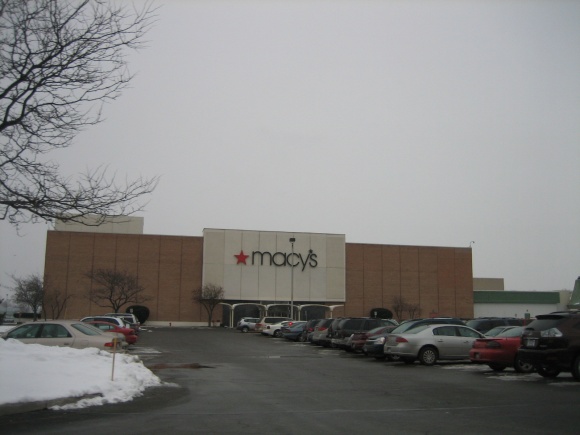 Next, McCurdy’s went a step further and decided to build an enclosed mall of its own, entirely separate from and directly adjacent to Greece Towne Mall. Right next to the already-open Greece Towne Mall, McCurdy’s built Long Ridge Mall, named after the adjacent intersection of Ridge Road (NY 104) and Long Pond Road, to connect their new McCurdy’s store to a Sears.
Next, McCurdy’s went a step further and decided to build an enclosed mall of its own, entirely separate from and directly adjacent to Greece Towne Mall. Right next to the already-open Greece Towne Mall, McCurdy’s built Long Ridge Mall, named after the adjacent intersection of Ridge Road (NY 104) and Long Pond Road, to connect their new McCurdy’s store to a Sears.
Some confusion here: I’ve now seen or heard four different dates the Sears supposedly opened. Wikipedia, mall-hall-of-fame, and others have said Sears opened as a stand-alone store predating both malls in 1959, while others have said Sears opened around the time Long Ridge Mall opened in 1971. I called the store myself and was told that it opened in 1967. What’s the right answer? See the thread in the comments for more details.
Long Ridge Mall opened in 1971, connecting Sears and McCurdy’s with a corridor of in-line stores between them. Long Ridge Mall also featured a 2-level, 123,000 square-foot J.B. Hunter discount store near the middle of the mall, along with Rochester-based B. Forman and Woolworth’s as junior anchors. Long Ridge was also significantly larger than its neighbor Greece Towne.
A good circa-1973 illustration of the two malls’ layouts can be seen here, courtesy mall-hall-of-fame.
J.B. Hunter didn’t last long at Long Ridge Mall. In 1973, the retailer went out of business; however, it was swiftly replaced with Rochester’s first full-line JCPenney.
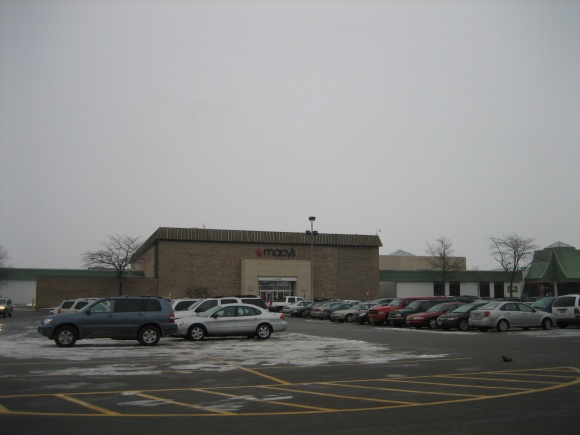 During the 1980s, the two adjacent Grecian malls competed with each other, and with metro Rochester’s other malls for shopper dollars and loyalty: Midtown Plaza, which opened in 1962 in downtown Rochester; Eastview Mall, which opened in 1971 in southeast-suburban Victor; and Marketplace Mall, which opened in 1982 in south-suburban Henrietta and became the area’s largest mall as soon as it debuted.
During the 1980s, the two adjacent Grecian malls competed with each other, and with metro Rochester’s other malls for shopper dollars and loyalty: Midtown Plaza, which opened in 1962 in downtown Rochester; Eastview Mall, which opened in 1971 in southeast-suburban Victor; and Marketplace Mall, which opened in 1982 in south-suburban Henrietta and became the area’s largest mall as soon as it debuted.
Greece Towne Mall also expanded in the 1980s, adding 10 more stores to the south end of the mall, giving it a cross shape. A 1-level 110,000 square-foot Gold Circle discount store, which was short-lived, was also added in the expansion. The Gold Circle chain was sold and dismantled in 1988, and the Greece Towne location became discounter Hills, and later on Caldor. In addition, a London Fog store (?) also operated as a mini-anchor at Greece Towne Mall, before closing and being split into Marshall’s and Michael’s in the late 1990s.
During the 1990s, both anchor changes and a major expansion would transform both Long Ridge Mall and Greece Towne Mall into the behemoth that exists today. In addition, Wilmorite brought a new mall, Irondequoit Mall, to Rochester’s retail scene in 1990, and expansion efforts transformed the average Eastview Mall across town into an upscale super-regional mega-mall seemingly overnight in 1995.
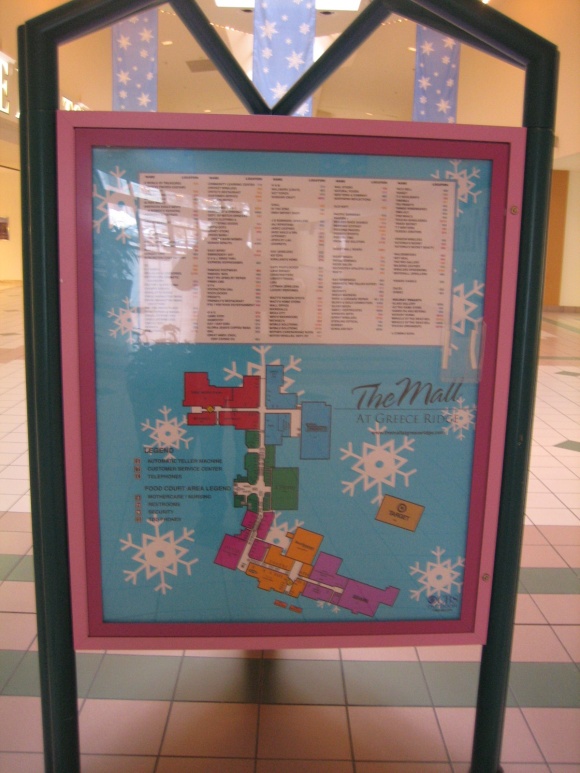 In 1990, the first of many anchor changes occurred at the two malls, when Sibley’s at Greece Towne Mall became Pittsburgh-based Kaufmann’s after May bought Sibley’s in 1986 and decided to consolidate nameplates 4 years later.
In 1990, the first of many anchor changes occurred at the two malls, when Sibley’s at Greece Towne Mall became Pittsburgh-based Kaufmann’s after May bought Sibley’s in 1986 and decided to consolidate nameplates 4 years later.
Sometime in the early 1990s, Wilmorite, which already owned Greece Towne Mall, acquired neighboring Long Ridge Mall with big plans in mind. In 1993, Wilmorite began constructing an enclosed corridor connecting the two malls, creating the largest mall in Rochester in the process. Opened in 1994, the new construction added over 50 stores and restaurants, including a 9-bay food court and a new 2-level, 164,000 square-foot JCPenney. The older malls were also extensively renovated to match, as best they could, the decor of the newer connection.
As part of the renovation, many works of public art in Long Ridge Mall were needlessly destroyed. For many years, Long Ridge Mall was home to over 40 works of public art on permanent display, designed by the mall’s architect, David William Bermant. These included a large kinetic ball sculpture and others, and most of these were thrown in the trash by Wilmorite when they gave the mall a uniform look. I’m not sure how this beats this? I would much rather shop, and linger, in the latter.
Many other changes came along with connecting Greece Towne Mall to Long Ridge Mall, the first of which being the mall’s name. Both of the old malls’ names were scrapped, and a new name was chosen: The Mall at Greece Ridge Center.
Second, many anchor changes took place around the time the malls were sewn together. The old JCPenney was subdivided between Burlington Coat Factory on the upper level, and Boston-based Lechmere on the lower level. Woolworth’s also closed around this time, and was replaced by Pittsburgh-based Dick’s Sporting Goods. B. Forman and Loblaw’s closed too, and McCurdy’s was rebranded as Pittsburgh-based Kaufmann’s. Kaufmann’s parent May bought McCurdy’s, and due to antitrust issues, Kaufmann’s was not allowed to rebrand both Sibley’s and McCurdy’s stores as May plates, so May chose to move Kaufmann’s from the old Sibley’s store in Greece Towne Mall to the better location in the former McCurdy’s. Bon Ton moved into the old Sibley’s store, and operates there to this day.
 Other big box anchors opened at Greece Ridge in the mid- to late-1990s, while a couple closed. They included Michael’s (1999), Marshall’s (?), Bed Bath & Beyond (1998), and Circuit City (1998) in the former Greece Towne Mall wing, and Dick’s Sporting Goods (1994), Kaufmann’s Home Store (1998), Barnes & Noble (?), and Old Navy (1994) in the former Long Ridge Mall wing. About the same time all of these stores opened, Caldor closed, and was replaced by a new Hoyt’s 12-plex movie theater in 1999. Lechmere closed too, in 1997.
Other big box anchors opened at Greece Ridge in the mid- to late-1990s, while a couple closed. They included Michael’s (1999), Marshall’s (?), Bed Bath & Beyond (1998), and Circuit City (1998) in the former Greece Towne Mall wing, and Dick’s Sporting Goods (1994), Kaufmann’s Home Store (1998), Barnes & Noble (?), and Old Navy (1994) in the former Long Ridge Mall wing. About the same time all of these stores opened, Caldor closed, and was replaced by a new Hoyt’s 12-plex movie theater in 1999. Lechmere closed too, in 1997.
The presence of all these box stores as anchors is an innovative way to use up space in a mall that is probably too big to effectively and successfully use the same space for smaller in-line shops. However, the former Greece Towne Mall corridors feel a bit barren due to the facades of the box stores, and the overall tone of the mall changes quite a bit between the barren, darker former Greece Towne Mall section and the newer, vervier 1994-95 addition.
The 2000s have been tantamount to success at Greece Ridge. In late 2000, a stand-alone 124,000 square-foot Target was added in the parking lot near Sears, and is considered part of the mall complex. In 2005, Burlington Coat Factory swapped space with the former Lechmere store, which had been located beneath it and was vacant since its closure in 1997. Also in 2005, Macerich acquired Wilmorite and the mall dropped the word ‘Center’ from its name.
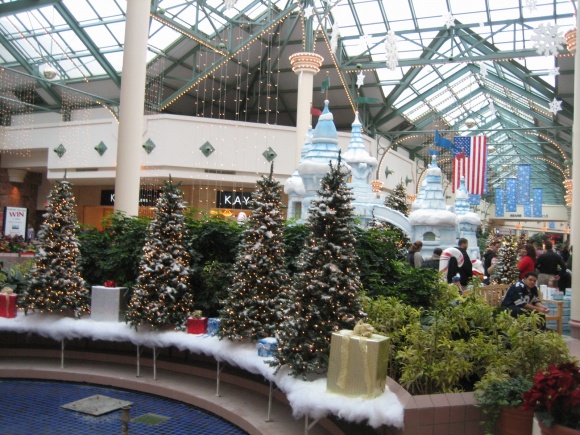 An anchor change took place in 2006, as both Kaufmann’s and Kaufmann’s Home Store got eaten by Macy’s after May Company was sold to Macy’s parent, Federated, who consolidated all of the former May banners to Macy’s. Finally, Circuit City, in the former Greece Towne wing of the mall, closed in 2009 when that chain flopped.
An anchor change took place in 2006, as both Kaufmann’s and Kaufmann’s Home Store got eaten by Macy’s after May Company was sold to Macy’s parent, Federated, who consolidated all of the former May banners to Macy’s. Finally, Circuit City, in the former Greece Towne wing of the mall, closed in 2009 when that chain flopped.
Today, Greece Ridge is a successful top-tier mall, and is both the largest and second best mall in the Rochester region, after Eastview. With three traditional anchors and many box store anchors, Greece Ridge is able to hold on to its size and still be successful. Without the box anchors, there would probably be too much space in the mall to fill, but having them both creates traffic and uses up space.
I visited Greece Ridge in December 2007 and took the pictures featured here, obviously sans the vintage ones that were taken before I was born. I really liked the franken-mall feel of this one, and even despite efforts to make the center uniform, there are definitely three separate tones the mall takes as you go through the long and winding corridors. The middle of the mall definitely feels (and is) newest, and is the vervey heart and soul of the mall. The design is very typical of modern Wilmorite, with the A-frame and skylight over the middle of the corridor, and the ancillary design accoutrements like the hidden mickeys and lighted archways. And, while the ancillary wings aren’t dead, the presence of many box stores leave some areas feeling a bit barren, especially in the old Greece Towne wing. As usual, feel free to leave your own comments, reactions, and experiences.
Elsewhere on the web:
 Metro Rochester’s fourth mall opened in 1971 near the intersection of Interstate 90 / NY Thruway and NY Route 96. Located 15 miles southeast of downtown in suburban Victor, Eastview Mall was developed by Rochester-based mall- maker Wilmorite, the same firm responsible for developing many of the region’s other centers. Eastview Mall was much smaller than the behemoth that stands today, and was originally anchored by Rochester-based Sibley’s department store and Sears, in a simple dumbbell configuration connecting the two anchors containing 80 in-line stores.
Metro Rochester’s fourth mall opened in 1971 near the intersection of Interstate 90 / NY Thruway and NY Route 96. Located 15 miles southeast of downtown in suburban Victor, Eastview Mall was developed by Rochester-based mall- maker Wilmorite, the same firm responsible for developing many of the region’s other centers. Eastview Mall was much smaller than the behemoth that stands today, and was originally anchored by Rochester-based Sibley’s department store and Sears, in a simple dumbbell configuration connecting the two anchors containing 80 in-line stores.
Metro Rochester’s fourth mall opened in 1971 near the intersection of Interstate 90 / NY Thruway and NY Route 96. Located 15 miles southeast of downtown in suburban Victor, Eastview Mall was developed by Rochester-based mall- maker Wilmorite, the same firm responsible for developing many of the region’s other centers. Eastview Mall was much smaller than the behemoth that stands today, and was originally anchored by Rochester-based Sibley’s department store and Sears, in a simple dumbbell configuration connecting the two anchors containing 80 in-line stores.
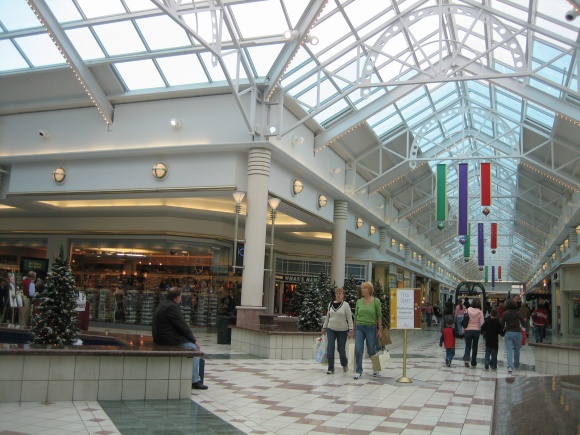 The first of several expansions at Eastview took place in 1973 as Rochester-based McCurdy’s department store was added as a third anchor, along with a 15-store expansion and a new west wing. With 95 stores, Eastview was the Rochester area’s largest mall until 1982, when The Marketplace Mall opened in south-suburban Henrietta. Eastview was also larger than Rochester’s other extant malls: Midtown Plaza, which opened in 1962, Greece Towne Mall, which opened in 1967, and Long Ridge Mall, which opened in 1972.
The first of several expansions at Eastview took place in 1973 as Rochester-based McCurdy’s department store was added as a third anchor, along with a 15-store expansion and a new west wing. With 95 stores, Eastview was the Rochester area’s largest mall until 1982, when The Marketplace Mall opened in south-suburban Henrietta. Eastview was also larger than Rochester’s other extant malls: Midtown Plaza, which opened in 1962, Greece Towne Mall, which opened in 1967, and Long Ridge Mall, which opened in 1972.
During the 1990s, anchor changes as well as major renovations and expansions changed the face of retailing in greater Rochester. In 1990, Wilmorite constructed a fifth mall in the region, Irondequoit Mall, located in northeast-suburban Irondequoit, about 2 miles from downtown Rochester. Irondequoit enjoyed a modicum of success during the 1990s, but quickly fell out of favor due to increased competition, an unfavorable location, and a perception of crime. By the year 2000, Irondequoit Mall was not a threat to the remaining retail centers, and the center closed in 2009.
Also in 1990, an anchor change took place at Eastview. Sibley’s became Pittsburgh-based Kaufmann’s after May Company, Kaufmann’s parent, purchased Sibley’s in 1986 and decided to consolidate nameplates.
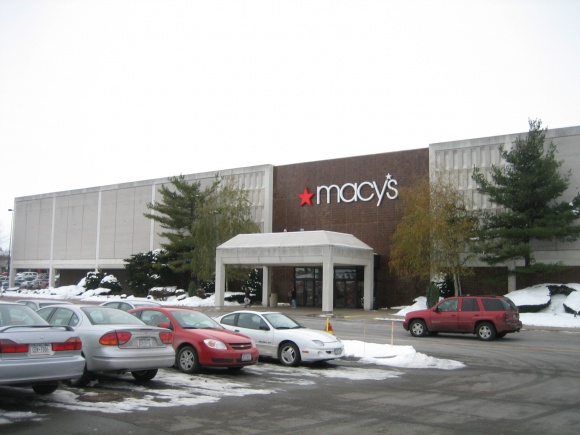 In 1994, another anchor change took place at Eastview, as May Company also acquired McCurdy’s. However, due to an antitrust settlement, May could not convert the McCurdy’s stores to Kaufmann’s as they had done with Sibley’s, and instead divested them to Bon Ton. The store remains Bon Ton today.
In 1994, another anchor change took place at Eastview, as May Company also acquired McCurdy’s. However, due to an antitrust settlement, May could not convert the McCurdy’s stores to Kaufmann’s as they had done with Sibley’s, and instead divested them to Bon Ton. The store remains Bon Ton today.
Also in 1994, adjacent crosstown rival malls Greece Towne Mall and Long Ridge Mall combined, creating a massive mall called The Mall at Greece Ridge Center with 1.6 million square feet of retail space, and Eastview embarked upon a massive expansion and renovation of its own. Eastview added 62 additional stores and a food court, along with two new anchors: a 147,000 square-foot 2 story JCPenney, and Lord and Taylor. This expansion, which was complete in 1995, gave Eastview Mall over 1 million square feet of retail space, and, although Greece Ridge became the largest mall in Rochester following its expansion, Eastview cornered an upscale niche and became the area’s most popular mall.
The expansion also gave Eastview a unique and interesting layout, giving shoppers the option of completing an indoor square rather than traversing a linear route. Also, Bon Ton opened a second mall entrance right next to the first one, due to being located at the crux of two hallways after the expansion. In addition, ancillary strip began popping up near Eastview, with several plazas popping up nearby.
 In 2003, Wilmorite expanded Eastview again, adding a 62,000-foot outdoor ‘lifestyle’ expansion to the mall’s main entrance along NY 96, containing 8-10 additional stores and restaurants. Like many ‘lifestyle’ expansions, this addition to the mall was stocked with upscale womens clothing retailers and ‘destinational’ restaurants, like PF Chang and Biaggi’s, as well as upscale home outfitter Pottery Barn.
In 2003, Wilmorite expanded Eastview again, adding a 62,000-foot outdoor ‘lifestyle’ expansion to the mall’s main entrance along NY 96, containing 8-10 additional stores and restaurants. Like many ‘lifestyle’ expansions, this addition to the mall was stocked with upscale womens clothing retailers and ‘destinational’ restaurants, like PF Chang and Biaggi’s, as well as upscale home outfitter Pottery Barn.
After the most recent expansion, Eastview Mall has over 1.3 million square feet of retail space, 5 department stores, and over 180 specialty stores and restaurants. More than 30 stores at Eastview are unique to the Rochester market, such as Apple, giving Eastview the best and most upscale store selection of any mall in the Rochester area.
The current incarnation of Eastview Mall proves the Field of Dreams theory on retail development, which I just invented: If you build it, shoppers will come. Eastview is, by far, the most distant mall in the Rochester area to the center of population; yet in contrast, it is the most popular mall in terms of selection. Also, according to Eastview’s Wikipedia entry, people frequently go to Eastview when visiting the nearby Finger Lakes region, a tourist region of upstate New York located a short distance south of the mall. Because of its wide draw, Eastview is the Rochester area’s only true super-regional mall.
We visited Eastview Mall in December 2007 and took the pictures featured here. Leave comments regarding your own experiences and stories.
 Marketplace Mall, located 3 miles south of downtown Rochester in the suburb of Henrietta, opened on October 7, 1982. Originally anchored by Rochester-based Sibley’s, McCurdy’s, and B. Forman, and complemented by national retailer Sears, Marketplace is home to 140 specialty stores and was, for many years, the largest mall in the Rochester area.
Marketplace Mall, located 3 miles south of downtown Rochester in the suburb of Henrietta, opened on October 7, 1982. Originally anchored by Rochester-based Sibley’s, McCurdy’s, and B. Forman, and complemented by national retailer Sears, Marketplace is home to 140 specialty stores and was, for many years, the largest mall in the Rochester area.
The Marketplace Mall, located 3 miles south of downtown Rochester in the suburb of Henrietta, opened on October 7, 1982. Originally anchored by Rochester-based Sibley’s, McCurdy’s, and B. Forman, and complemented by national retailer Sears, Marketplace is home to 140 specialty stores and was, for many years, the largest mall in the Rochester area.
The Marketplace Mall was developed by Wilmorite, a Rochester-based retail developer that developed all four of Rochester’s suburban malls. Wilmorite still owns and manages Marketplace, along with several other Rochester malls.
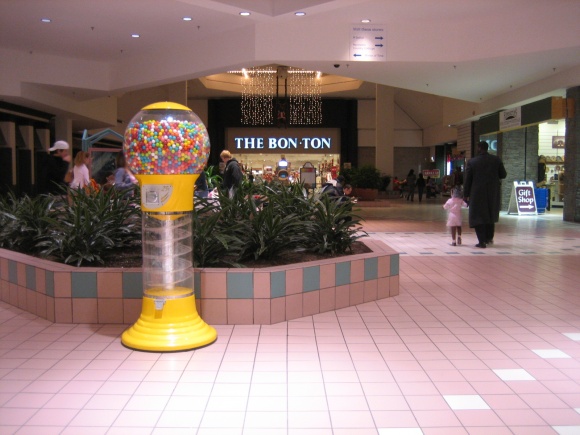 The Marketplace has expanded twice in its 28-year history. In 1983, JCPenney opened as the mall’s east anchor, and in 2001 a 2-story, 86,000 square-foot Galyan’s sporting goods store was added as the northwest anchor. The expansions brought the mall to 1.6 million square feet of retail space including the anchors, with 350,000 square feet of in-line retail.
The Marketplace has expanded twice in its 28-year history. In 1983, JCPenney opened as the mall’s east anchor, and in 2001 a 2-story, 86,000 square-foot Galyan’s sporting goods store was added as the northwest anchor. The expansions brought the mall to 1.6 million square feet of retail space including the anchors, with 350,000 square feet of in-line retail.
The Marketplace Mall is located along one of the best and biggest retail corridors in metro Rochester. Nearly 5 million square feet of retail space is located within 2 miles of the mall, including many national big box chains and numerous strip malls.
In addition, The Marketplace benefits from having over 50,000 students at 3 schools nearby. Marketplace is the closest mall to all three of them: Rochester Institute of Technology, Monroe Community College, and The University of Rochester.
Also, The Marketplace benefits from access to I-390, which is less than a quarter mile from the mall, while I-90 and the New York State Thruway are two miles away.
 Several anchor changes have taken place at The Marketplace since it opened. Sibley’s was converted to Pittsburgh-based Kaufmann’s in 1990, and McCurdy’s became Bon Ton in the mid-1990s. B. Forman also closed before the chain folded, and in 2006, Kaufmann’s became Macy’s. Also, Galyan’s, which opened in 2001, was acquired by and converted to Dick’s in 2004.
Several anchor changes have taken place at The Marketplace since it opened. Sibley’s was converted to Pittsburgh-based Kaufmann’s in 1990, and McCurdy’s became Bon Ton in the mid-1990s. B. Forman also closed before the chain folded, and in 2006, Kaufmann’s became Macy’s. Also, Galyan’s, which opened in 2001, was acquired by and converted to Dick’s in 2004.
Although The Marketplace opened as the largest mall in the Rochester region in the early 1980s, other malls have since given it competition through opening and expansion. In 1990, Irondequoit Mall opened as a brand new mall in Rochester’s northeast suburbs; however, its success was short-lived due to its location and perception of crime. It closed in 2009 pending future rejuvenation. In the mid-1990s, both Greece Ridge and Eastview Malls expanded dramatically, and Eastview expanded again in 2003, giving it market dominance and the best selection of stores in metro Rochester. In addition, a fifth metro Rochester mall located downtown, Midtown Plaza, closed in 2008 after years of struggles.
Today, The Marketplace Mall holds its own due its centralized location in Rochester, within reach of 50,000 college students, easy accessibility from freeways, and situation on one of the best retail strips around. However, despite a renovation of the center court in 2006, much of the mall appears somewhat dated in our 2007 photo set. Take a look at the JCPenney photo, featuring the fun angled wood facade, and also look at the flooring, which appears to have been put in sometime in the late 1980s or early 1990s.
We visited The Marketplace Mall in December 2007 and took the photos featured here, with the exception of the top photo above, which came from The Marketplace Mall’s own website. What do you think of the mall? Please leave your comments, experiences, and reactions on the comments page.
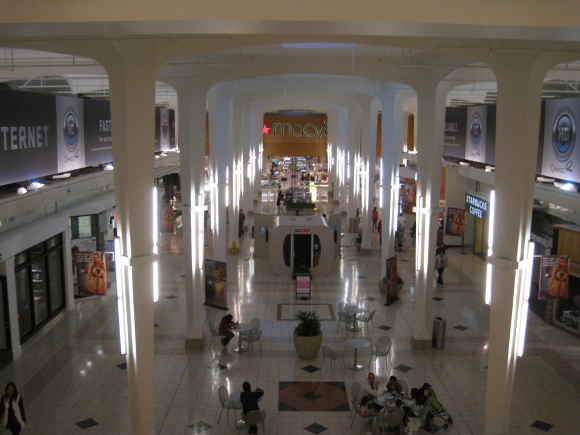 Westfield Southcenter is not only the biggest mall in the Seattle area, but it’s also the largest mall in the entire Pacific Northwest. Located at the intersection of I-405 and I-5, about 10 miles south of downtown Seattle and 20 miles north of Tacoma, Westfield Southcenter is a super-regional draw in western Washington, drawing shoppers from all parts of the Seattle-Tacoma metropolitan area, a region home to 3.5 million people. Southcenter was developed by Allied Stores, an established department store conglomerate which also owned Seattle-based The Bon Marché.
Westfield Southcenter is not only the biggest mall in the Seattle area, but it’s also the largest mall in the entire Pacific Northwest. Located at the intersection of I-405 and I-5, about 10 miles south of downtown Seattle and 20 miles north of Tacoma, Westfield Southcenter is a super-regional draw in western Washington, drawing shoppers from all parts of the Seattle-Tacoma metropolitan area, a region home to 3.5 million people. Southcenter was developed by Allied Stores, an established department store conglomerate which also owned Seattle-based The Bon Marché.
Recently, we discovered a major hole in our Pacific Northwest coverage. We consider this a major oversight, because we’ve visited most of the malls in Oregon and British Columbia, as well as in western Washington. However, we’ve neglected to post anything in one of the largest cities in the country, Seattle.
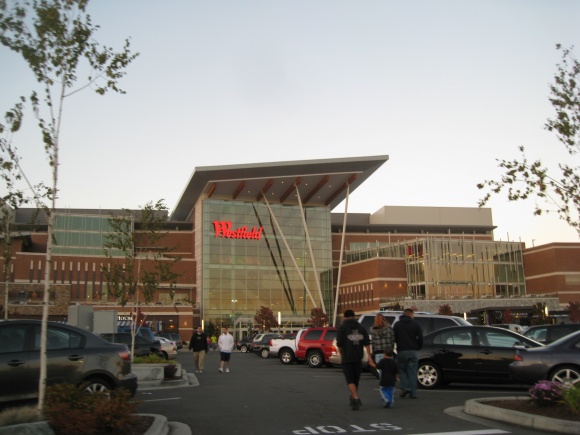 So, it seems somewhat fitting to have a big Seattle debut, right? Westfield Southcenter is not only the biggest mall in the Seattle area, but it’s also the largest mall in the entire Pacific Northwest. Located at the intersection of I-405 and I-5, about 10 miles south of downtown Seattle and 20 miles north of Tacoma, Westfield Southcenter is a super-regional draw in western Washington, drawing shoppers from all parts of the Seattle-Tacoma metropolitan area, a region home to 3.5 million people.
So, it seems somewhat fitting to have a big Seattle debut, right? Westfield Southcenter is not only the biggest mall in the Seattle area, but it’s also the largest mall in the entire Pacific Northwest. Located at the intersection of I-405 and I-5, about 10 miles south of downtown Seattle and 20 miles north of Tacoma, Westfield Southcenter is a super-regional draw in western Washington, drawing shoppers from all parts of the Seattle-Tacoma metropolitan area, a region home to 3.5 million people.
Westfield Southcenter opened to humbler beginnings in 1968 as Southcenter Mall. Strategically located at the intersection of Interstate 5, the major north-south corridor through western Washington and the Pacific Northwest, and Interstate 405, which connects Interstate 5 to Seattle’s suburbs on the eastern side of Lake Washington, Southcenter’s success was predicated on this accessibility.
According to mall-hall-of-fame, Southcenter Mall originally had 116 stores on a single level, anchored by three Seattle-based department stores: a 170,000 square-foot Frederick and Nelson, a 240,000 square-foot Bon Marché, and a smaller Nordstrom Best.
Here’s an early shot of the Frederick and Nelson (later Sears) store, courtesy Malls of America:
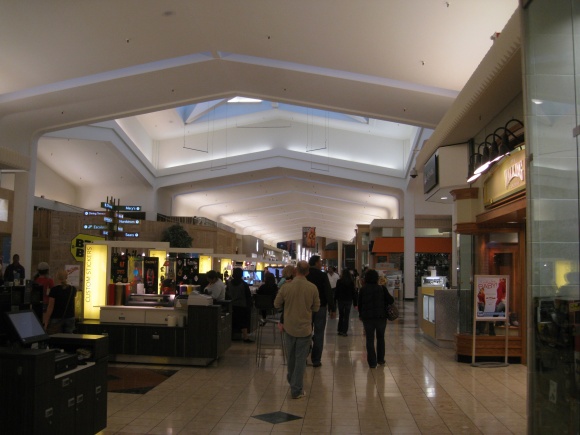 For those unfamiliar with Nordstrom’s history, prepare to get schooled. The venerable retailer started in 1901 as a shoe store in Seattle. Here’s what I didn’t know, and you may not either: Nordstrom only sold shoes until 1963, when it merged with a Seattle apparel store called Best Apparel. The name was then changed to Nordstrom Best, and later to just Nordstrom by 1973.
For those unfamiliar with Nordstrom’s history, prepare to get schooled. The venerable retailer started in 1901 as a shoe store in Seattle. Here’s what I didn’t know, and you may not either: Nordstrom only sold shoes until 1963, when it merged with a Seattle apparel store called Best Apparel. The name was then changed to Nordstrom Best, and later to just Nordstrom by 1973.
Southcenter was developed by Allied Stores, an established department store conglomerate which also owned Seattle-based The Bon Marché. Not surprisingly, Bon Marché was featured as the centerpiece of Southcenter Mall, in the middle of the mall along the main hallway. The court in front of Bon Marché featured an impressive atrium called Columnarium, the focal piece of the mall, which still exists today. Another smaller court, East Court, between Bon Marché and JCPenney, was known for its stunning hanging chandeliers. Allied also developed nearby Tacoma Mall in 1965, using a similar layout, and Northgate Mall, in Seattle, in 1950.
Also present at Southcenter was a 270,000 square-foot JCPenney store flanking the eastern end of the mall, which was the largest in the chain at the time, and a Lucky Supermarket at the south end. Here’s an early shot of the JCPenney, courtesy Malls of America:
Here’s an early shot of the Columnarium, courtesy of DSHistory.com:
And a similar shot of the Columnarium as it stands today (October 2010):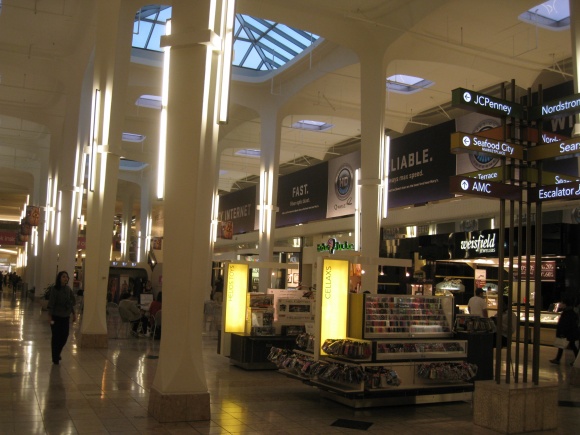 :
:
Few changes took place at Southcenter during the 1970s and 1980s. A Cinerama-style movie theater, one of the last of its kind, opened in 1970. And, as mentioned above, Nordstrom Best turned into simply Nordstrom in 1973, and in 1989 the Lucky Supermarket closed and was replaced by a food court.
In 1992, two major changes took place at Southcenter. First, Frederick and Nelson closed up shop and was quickly replaced by Sears. Second, a new 13-store wing was added to the eastern end of the mall, ending at a two-level, 86,000 square-foot Mervyn’s.
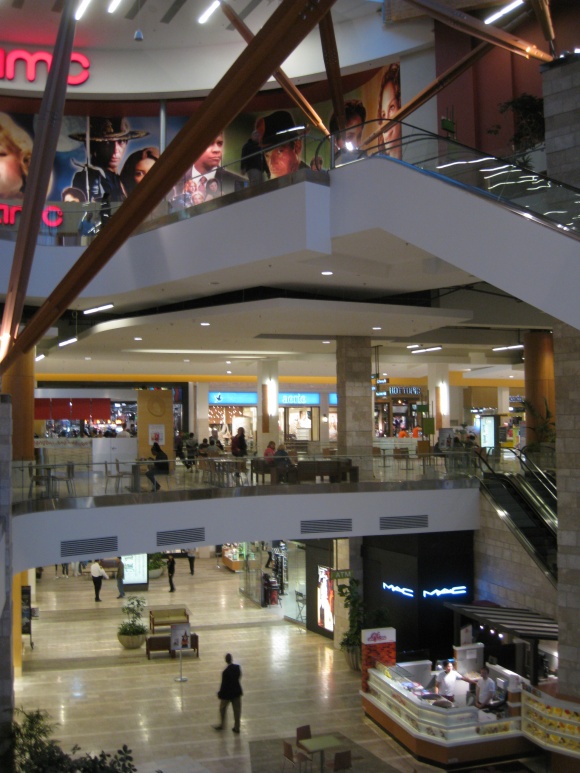 The 2000s brought even bigger changes to Southcenter, culminating in a renovation and expansion, which was complete in 2008. First, in 2002, Westfield purchased the mall, changing its name from Southcenter Mall to Westfield Shoppingtown Southcenter. Then, in 2003, Federated decided to phase out the venerable Bon Marché name in favor of Bon-Macys. By 2005, Bon-Macys was rebranded as just Macys, and Westfield dropped the rather stupid ‘Shoppingtown’ moniker.
The 2000s brought even bigger changes to Southcenter, culminating in a renovation and expansion, which was complete in 2008. First, in 2002, Westfield purchased the mall, changing its name from Southcenter Mall to Westfield Shoppingtown Southcenter. Then, in 2003, Federated decided to phase out the venerable Bon Marché name in favor of Bon-Macys. By 2005, Bon-Macys was rebranded as just Macys, and Westfield dropped the rather stupid ‘Shoppingtown’ moniker.
In 2006, a massive expansion project began, which added a new southern wing parallel to the original mall, with 300,000 square feet of additional space, 75 new stores, 5 sit-down restaurants, 2 parking structures, an AMC Multiplex Theater, and an expanded second-level food court with views of Mount Rainier. The expansion was dedicated July 25, 2008, almost exactly 40 years after the mall’s grand opening.
During the expansion, in 2006, troubled and now non-existant retailer Mervyn’s shuttered their stores in the Pacific Northwest, including the one at Southcenter. After remaining shuttered for several years, Westfield secured a non-traditional anchor tenant, Seafood City Supermarket, to retenant the space in 2010. Seafood City is an asian-themed supermarket with an emphasis on Filipino items, and helped establish an Asian-themed wing of Southcenter, complementing fast-food restaurant Jolibee and other Asian-themed retailers also in operation. This theming is a creative way of dealing with having a short wing die in an otherwise successful mall.
Here’s a shot looking south from the food court. If you look closely, you can see the outline of Mount Rainier at sunset behind the trees:
Caldor and I visited Southcenter Mall together in October 2010 and took the pictures featured here. Leave some of your own experiences and impressions in the comments.
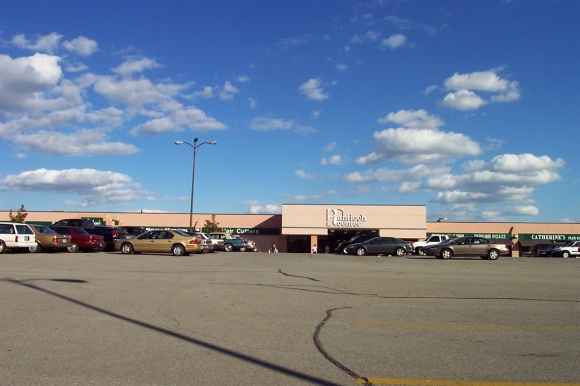 In 1954, more than 30 years after Country Club Plaza opened, construction began on a new style of suburban shopping center. Located on the north side of Kansas City, in an area known as the Northland, Antioch Center was built on a 42-acre vacant section of land that had just recently been annexed into Kansas City in 1950. Just like The Plaza, Antioch Center was built with the automobile in mind. However, the auto-centric developments of the 1950s trended toward building on the edges of cities, where land was cheap and plentiful. Such a large space could have a retail center located in the middle of the property, with a sea of parking lots surrounding it on all sides for convenience, and more developer control over every facet of the project.
In 1954, more than 30 years after Country Club Plaza opened, construction began on a new style of suburban shopping center. Located on the north side of Kansas City, in an area known as the Northland, Antioch Center was built on a 42-acre vacant section of land that had just recently been annexed into Kansas City in 1950. Just like The Plaza, Antioch Center was built with the automobile in mind. However, the auto-centric developments of the 1950s trended toward building on the edges of cities, where land was cheap and plentiful. Such a large space could have a retail center located in the middle of the property, with a sea of parking lots surrounding it on all sides for convenience, and more developer control over every facet of the project.
Back in 2007, we published a case study of malls in the Kansas City area. In doing so, we discovered one of the most extreme examples of retail overbuilding in the country. Of the region’s once 15 enclosed malls, only two remain viable as regional or super-regional draws: Independence Center, located in east-suburban Independence, and Oak Park Mall, located in southwest-suburban Overland Park. The rest have been marginalized to ancillary status, like Ward Parkway Center in south Kansas City, and many others are either underutilized, on life support, or have closed completely since we posted the case study. One of the malls we profiled, Antioch Center, was still on life support when we originally published our case study, but has since closed and as of late 2010 is pending demolition.
Born in 1956 as an outdoor plaza with almost 500,000 square feet, Antioch Center was the second major shopping center in Kansas City, and was the first major suburban-style center in the region.
But first, an aside and caveat of sorts. The first shopping center in Kansas City was the storied Country Club Plaza, located 4 miles south of downtown. Country Club Plaza was an innovator in shopping center design, and although it was not the first shopping center to be constructed outside of a city’s downtown/central business district, it is generally accepted to be the first shopping center to be constructed with the automobile in mind. Designed to look like a neighborhood in Seville, Spain, The Plaza opened in 1923 to immediate and lasting success. Over time, the Plaza has upscaled its offerings and is currently the best shopping district in Kansas City.
Country Club Plaza (wikipedia):
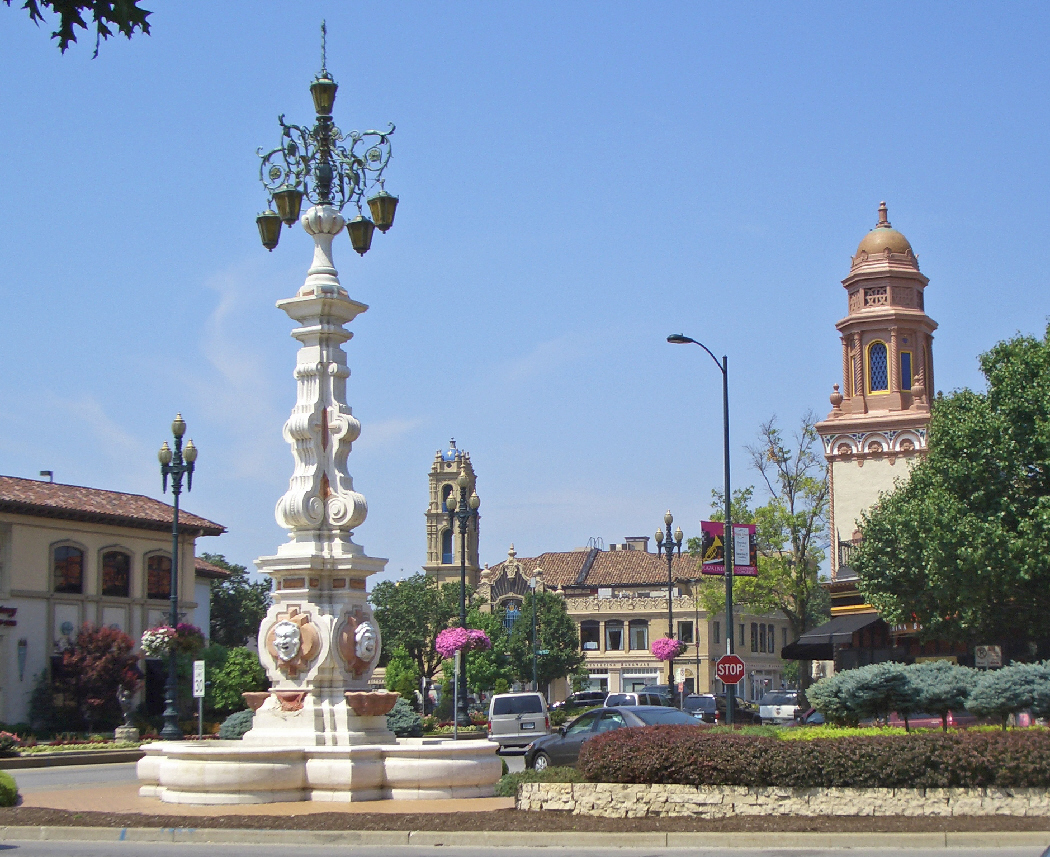
However, despite The Plaza’s innovative success, a distinction has to be made between The Plaza and the suburban shopping centers it predated, such as Antioch Center, and all the enclosed malls which came many decades later. The Plaza is designed as a traditional neighborhood, and its streets are intertwined into Kansas City’s normal grid. There are no parking lots surrounding the development, and no standalone buildings like a mall would have. The entirety of The Plaza consists of regular streetfront retail, mostly justified to the sidewalk, causing The Plaza to behave as a distinct neighborhood rather than the more modern shopping centers we’re more familiar with. If anything, it’s the precursor to many of the modern “lifestyle centers” and fake neighborhood main street things popping up all over today.
 In 1954, more than 30 years after Country Club Plaza opened, construction began on a new style of suburban shopping center. Located on the north side of Kansas City, in an area known as the Northland, Antioch Center was built on a 42-acre vacant section of land that had just recently been annexed into Kansas City in 1950. Just like The Plaza, Antioch Center was built with the automobile in mind. However, the auto-centric developments of the 1950s trended toward building on the edges of cities, where land was cheap and plentiful. Such a large space could have a retail center located in the middle of the property, with a sea of parking lots surrounding it on all sides for convenience, and more developer control over every facet of the project.
In 1954, more than 30 years after Country Club Plaza opened, construction began on a new style of suburban shopping center. Located on the north side of Kansas City, in an area known as the Northland, Antioch Center was built on a 42-acre vacant section of land that had just recently been annexed into Kansas City in 1950. Just like The Plaza, Antioch Center was built with the automobile in mind. However, the auto-centric developments of the 1950s trended toward building on the edges of cities, where land was cheap and plentiful. Such a large space could have a retail center located in the middle of the property, with a sea of parking lots surrounding it on all sides for convenience, and more developer control over every facet of the project.
Antioch Center opened in 1956 as a 481,600 square-foot open-air center, anchored by a two-level, 102,000 square-foot Macy’s Kansas City on the north end, and was joined by junior anchors Woolworth and W.T. Grant. According to mall-hall-of-fame, the open-air mall complex was two levels, with a basement level facing the parking lot.
It wasn’t long before the first competition came for Antioch Center. In 1958, another open-air center, Blue Ridge Mall, opened just east of downtown Kansas City. Blue Ridge, anchored by JCPenney and Montgomery Ward, was about the same size as Antioch Center and had a similar selection of in-line stores. Antioch Center was mostly unfettered by this competition, though, because its trade area consisted mostly of the rapidly growing Northland area of Kansas City. Blue Ridge served the growing eastern section of town, and Country Club Plaza served everybody in a separate league altogether.
A year after Blue Ridge arrived on the scene, in 1959, another outdoor mall debuted in south Kansas City: Ward Parkway Center, anchored by Montgomery Ward. Ward Parkway was similar to the two outdoor malls before it.
In the 1960s, Antioch Center, Country Club Plaza, Ward Parkway Center and Blue Ridge Mall were the four main shopping centers in Kansas City until local developer Sherman Dreiseszun decided to develop two new enclosed malls in the region. The first was East Hills Mall, located about 50 miles north of Kansas City in St. Joseph, and the second was Metcalf South, a mall we’ve featured on this site, which opened in Overland Park in 1967. Metcalf South was the first enclosed mall in Kansas City, balking and changing the trend of the outdoor centers that previously dominated the market.
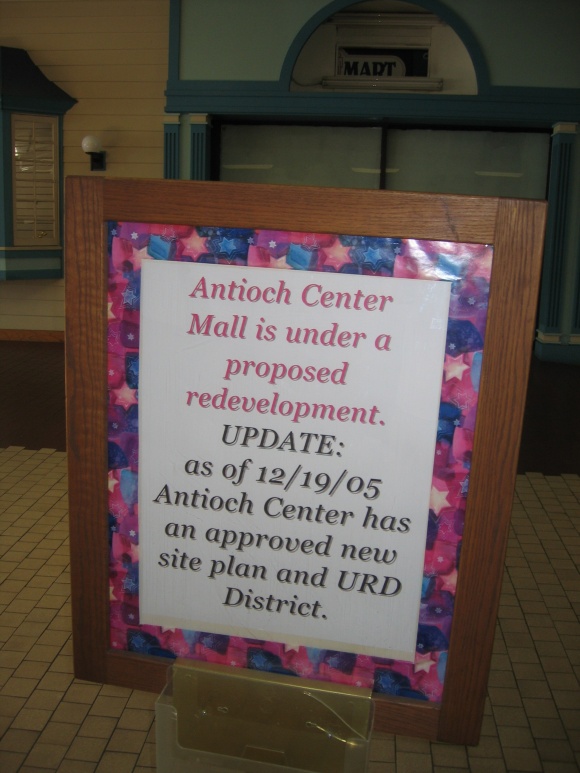 The 1970s provided much more serious and brutal competition for Antioch Center, as many more regional and super-regional malls were constructed in the region. In 1971, Indian Springs Center opened in Kansas City, Kansas to serve the western side of the region, and between 1974 and 1976 three regional powerhouse malls opened – Independence Center, Metro North Mall, and Oak Park Mall.
The 1970s provided much more serious and brutal competition for Antioch Center, as many more regional and super-regional malls were constructed in the region. In 1971, Indian Springs Center opened in Kansas City, Kansas to serve the western side of the region, and between 1974 and 1976 three regional powerhouse malls opened – Independence Center, Metro North Mall, and Oak Park Mall.
Meanwhile, the 1970s brought change to Antioch Center as well. In 1973-74, a 185,000 square foot wing was added to the north end of the mall, ending at a 100,000 square-foot Sears anchor. In response to all the new competition and the swinging trend toward enclosed, climate-controlled malls, both Blue Ridge Mall and Antioch Center were fully enclosed by 1978.
Enclosure brought success and bought time for Antioch Center as it grappled to compete with all of Kansas City’s new enclosed behemoths. Metro North Mall was Antioch Center’s biggest competitor with 1.3 million square feet of retail space, compared to Antioch’s post-expansion total of 667,000 square feet. The sum total of the rest of the new malls also ensured that Antioch Center was no longer a regional draw, and only drew from locals in the Northland who couldn’t be bothered to go to Metro North Mall, effectively making Antioch an ancillary to Metro North.
In the 1980s, Antioch Center rode the modicum of post-expansion express train as it settled into its new position as an ancillary, neighborhood mall. Incidently, the very first Showbiz Pizza opened at Antioch Center in 1980, the same year that yet another behemoth mall, Bannister Mall, was constructed across town.
In 1986, anchor changes at Antioch Center began, with the closure of Macy’s as they left the Kansas City area. Dillards, a rapidly expanding chain from neighboring Arkansas, quickly snatched up the anchor for a new store.
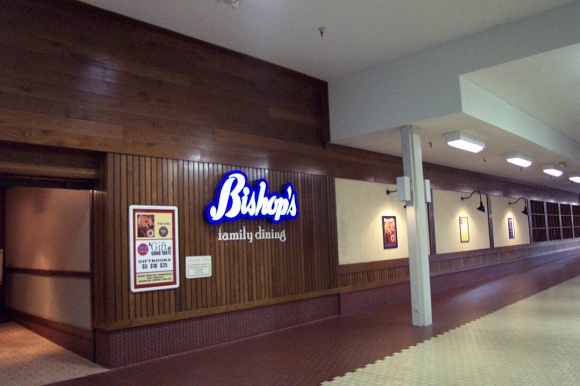 Any success Antioch Center had came to an end during the 1990s, even despite an exterior renovation of the mall in 1993, and a store expansion by Sears in 1997-98. Dillards also closed after a short 6-year stint at the mall, but its store was quickly snatched up by Burlington Coat Factory. Also at some point, Woolworths became Payless Cashways, a home improvement box. Stores began leaving the mall as shoppers eschewed stopping here in favor of all of the others Kansas City built for them.
Any success Antioch Center had came to an end during the 1990s, even despite an exterior renovation of the mall in 1993, and a store expansion by Sears in 1997-98. Dillards also closed after a short 6-year stint at the mall, but its store was quickly snatched up by Burlington Coat Factory. Also at some point, Woolworths became Payless Cashways, a home improvement box. Stores began leaving the mall as shoppers eschewed stopping here in favor of all of the others Kansas City built for them.
For a period, beginning the late 1990s, Antioch Center was marketed as a value-oriented mall, but after the turn of the millenium it was clear that didn’t work, either. Payless Cashways went out of business in 2001, and the food court became increasingly barren thereafter. Many stores exited the mall in droves, leaving vacancies in their wake.
The tides had turned into an irreversable downward spiral, and the mall was sold to a group of investors from Toronto in 2002. They put together plans for a total renovation in 2004, which involved tearing down most of the mall sans Sears and BCF, and replacing it with a lifestyle center of sorts, paid for by tax abatements. Unfortunately, the project met numerous delays and setbacks, including the economic downturn, causing the investors from Toronto to walk away from the project in 2010, turning it over to M&I Bank.
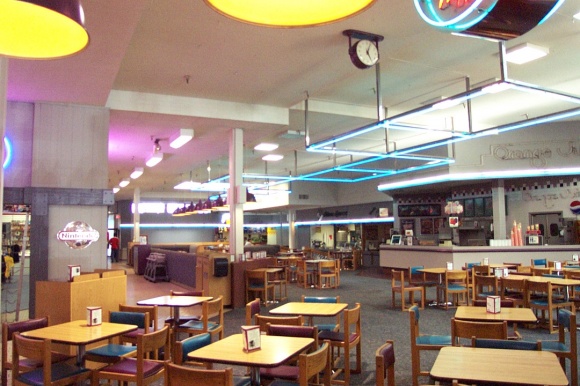 Meanwhile, the remaining stores in the interior corridor of the mall have closed, and the mall was permanently sealed. Sears and BCF remain committed to the mall and its renovation, and have stated that they will remain open no matter what.
Meanwhile, the remaining stores in the interior corridor of the mall have closed, and the mall was permanently sealed. Sears and BCF remain committed to the mall and its renovation, and have stated that they will remain open no matter what.
In September of 2010, a group of local investors who call themselves Antioch Redevelopment Partners bought the mall from the bank and hoped to get the ball rolling again. They are the same investors who redeveloped the troubled Blue Ridge Mall into a Wal-Mart, and locals are optimistic when leveraging their “success” on that project. They plan to start razing the mall by January 2011, but also may need more TIF money from the city. We’ll see what happens. The title of this article could have remained the same since 2004, yet nothing has happened.
Since the mall no longer exists as such, I went on web.archive.org and stole the mall’s most recent directory as well as its logo, featured above. I hope nobody cares.
We’ve visited Antioch Mall several times, beginning in the early 2000s, noting the visible downward spiral of the mall. Take a look at the pictures and leave some comments and let us know what you think.
2003:
2005:
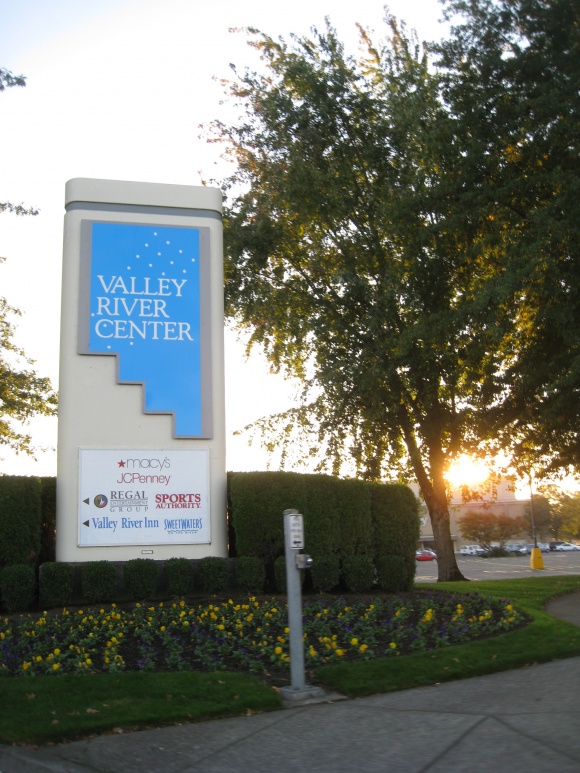 When it opened, Valley River Center was the largest fully-enclosed mall in the state of Oregon. Today the mall is the third largest in the state, after Portland’s Lloyd Center and suburban Portland’s Washington Square. It’s also the largest mall between Portland and the San Francisco Bay Area – though that’s not saying much, considering the only competition is Medford, Redding, and Eureka.
When it opened, Valley River Center was the largest fully-enclosed mall in the state of Oregon. Today the mall is the third largest in the state, after Portland’s Lloyd Center and suburban Portland’s Washington Square. It’s also the largest mall between Portland and the San Francisco Bay Area – though that’s not saying much, considering the only competition is Medford, Redding, and Eureka.
Despite being the largest mall in Oregon at the time, the 1969 version of Valley River Center was much smaller than the behemoth it is today. The original mall consisted of two two-level anchors, a 181,000 square-foot Portland-based Meier & Frank, and a 206,000 square-foot JCPenney, which opened a few months later. These two anchors were connected by an enclosed single-level retail corridor, where San Francisco-based Roos-Atkins also operated a 35,000 square foot junior anchor on the east side of the mall near Meier and Frank. In total, the entire mall was 662,000 square feet, and was fully operational by early 1970.
Located in west-central Oregon about 100 miles south of Portland, Eugene is the state’s second largest city and home to the University of Oregon. With 156,000 people in the city, the metropolitan area is home to around 350,000 residents. While Eugene is tied for Oregon’s second largest city with Salem, Oregon’s capital, Eugene’s metropolitan area is slightly smaller than Salem’s, and third in the state. In addition to the university, Eugene’s economy is based in recreational vehicle and wood products manufacturing. Eugene is also known for its quirky, offbeat culture, athletics (mainly track and field), and rabid environmentalism.
Eugene’s retail is clustered in several locations around the city, as well as in neighboring Springfield, located on the other side of Interstate 5. The closest mall to downtown Eugene, Valley River Center, opened in August 1969 following several years of planning and construction.
When it opened, Valley River Center was the largest fully-enclosed mall in the state of Oregon. Today the mall is the fourth largest in the state, after Portland’s Lloyd Center, Washington Square and Clackamas Town Center. It’s also the largest mall between Portland and the San Francisco Bay Area – though that’s not saying much, considering the only competition is in Medford, Redding, and Eureka.
Despite being the largest mall in Oregon at the time, the 1969 version of Valley River Center was much smaller than the behemoth it is today. The original mall consisted of two two-level anchors, a 181,000 square-foot Portland-based Meier & Frank, and a 206,000 square-foot JCPenney that opened a few months later. These two anchors were connected by an enclosed single-level retail corridor, where San Francisco-based Roos-Atkins also operated a 35,000 square foot junior anchor on the east side of the mall near Meier and Frank. In total, the entire mall was 662,000 square feet, and was fully operational by early 1970. Here’s a vintage shot of center court courtesy Malls of America:
The Meier and Frank store at Valley River Center was designed by then-owner May Stores, based in St. Louis, and featured a large upside-down funnel hanging over the south entrance. This design feature was also used on May’s St. Louis nameplate, Famous-Barr, in at least a couple stores I can think of: at the now defunct Northwest Plaza, and at South County Center. This original store is still in use by Macy’s, upside-down cylinder and all, and can be seen here:
A few years later, in 1974 and 1975, Valley River Center was expanded with a new western wing, ending in a one-level, 100,000 square-foot Montgomery Ward, the mall’s third anchor. Also that year, a 52,000 square-foot two-level junior anchor, Portland-based Lipman’s, was constructed in the east parking lot, attached to the mall where the new Wards wing intersects the old wing. The result was a cross configuration of mall corridors, with each radial ending at an anchor store.
The new wing also included an upper level mezzanine on its western end, featuring a Nordstrom Place Two which opened in May 1977. Nordstrom Place Two was Nordstrom’s attempt to enter smaller markets, with smaller stores featuring a limited apparel selection.
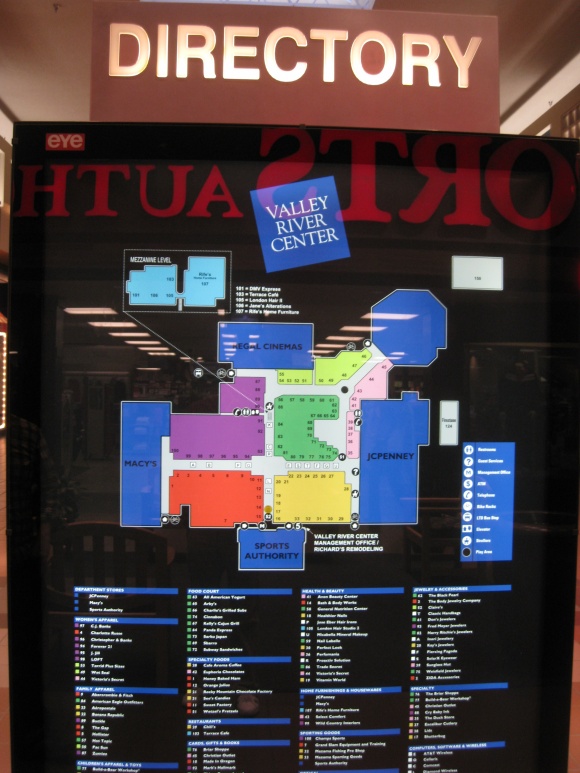 Another change taking place in the early- to mid-1970s was the departure of junior anchor Roos-Atkins, which was replaced with an 18,000 square foot Eugene-based Troutman’s Emporium, a regional department store, by 1975.
Another change taking place in the early- to mid-1970s was the departure of junior anchor Roos-Atkins, which was replaced with an 18,000 square foot Eugene-based Troutman’s Emporium, a regional department store, by 1975.
In 1979, the Lipman’s store, which was owned by Minneapolis-based Dayton-Hudson, got purchased by Chicago-based Marshall Field’s, who rebranded it to their Seattle-based Frederick & Nelson nameplate. Ironically, Dayton-Hudson would later own Marshall Field’s from 1990-2004 before selling them to May, who owned Meier & Frank, and then to Macy’s to focus on their Target division. Full circle collision!
The next change at Valley River took place in 1984, when Emporium expanded their store to the upper level of their building, resulting in a larger 45,000 square-foot store.
An 11-bay food court was added in 1986 to a side wing on the north end of the mall, near JCPenney.
Also in 1986, Marshall Field’s parent BATUS, based in Louisville, sold their Pacific Northwest holdings, including Frederick & Nelson, to local investors because the chain was flagging. The new owners removed the Frederick & Nelson nameplate from their store here and replaced it with Spokane-based The Crescent, rebadging it as a Crescent Outlet because it was smaller than a normal department store. This configuration didn’t last long, however, because the Frederick & Nelson/Crescent chain was going downhill fast, and the store was sold to Seattle-based Lamonts in 1988.
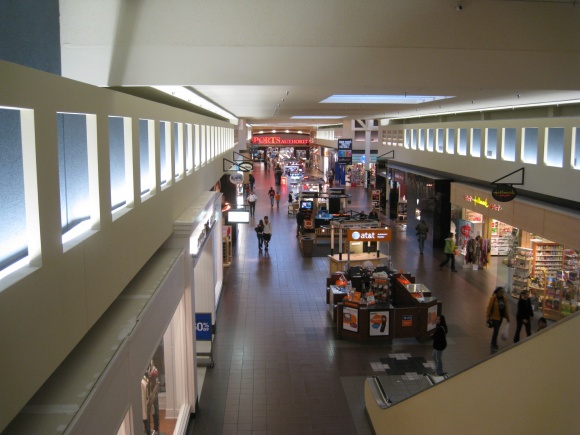 Also in 1988, a major announcement shook the Eugene retail scene – a brand new, 750,000 square foot mall was going to be constructed along Interstate 5 in Springfield, just a few miles east of Valley River Center. In response, Valley River owners decided to expand the mall again, adding a new northwest wing and a two-level, 124,000 square-foot Seattle-based The Bon Marché. The new wing connected the west wing expansion with the food court area, and is parallel to the original wing. This created an efficient loop within the mall. The expansion brought the mall to over 1 million square feet in leasable space and came in line by 1990, the same year the new Gateway Mall opened in nearby Springfield.
Also in 1988, a major announcement shook the Eugene retail scene – a brand new, 750,000 square foot mall was going to be constructed along Interstate 5 in Springfield, just a few miles east of Valley River Center. In response, Valley River owners decided to expand the mall again, adding a new northwest wing and a two-level, 124,000 square-foot Seattle-based The Bon Marché. The new wing connected the west wing expansion with the food court area, and is parallel to the original wing. This created an efficient loop within the mall. The expansion brought the mall to over 1 million square feet in leasable space and came in line by 1990, the same year the new Gateway Mall opened in nearby Springfield.
 In the 1990s, Valley River Center held its own against the brand new Gateway Mall, which can be attributed to its central location, just one mile north of downtown Eugene, and its sheer size. Some anchor changes also took place in the 1990s. In 1992, Nordstom Place Two closed because the concept wasn’t making the chain enough money; interestingly, Nordstrom has yet to return to Eugene and build a regular store. Nordstrom does operate a small store in downtown Salem, a similarly sized city. In 1996, Lamonts closed amid fiscal troubles for that chain, but it wasn’t vacant long. In early 1997 San Luis Obispo, Calif.-based Copeland’s Sports moved into the former Lamonts space.
In the 1990s, Valley River Center held its own against the brand new Gateway Mall, which can be attributed to its central location, just one mile north of downtown Eugene, and its sheer size. Some anchor changes also took place in the 1990s. In 1992, Nordstom Place Two closed because the concept wasn’t making the chain enough money; interestingly, Nordstrom has yet to return to Eugene and build a regular store. Nordstrom does operate a small store in downtown Salem, a similarly sized city. In 1996, Lamonts closed amid fiscal troubles for that chain, but it wasn’t vacant long. In early 1997 San Luis Obispo, Calif.-based Copeland’s Sports moved into the former Lamonts space.
In late 2000, Montgomery Ward announced it was going out of business, and the Wards at Valley River Center closed sometime in early 2001. Then, starting in 2003, the mall received some much-needed cosmetic renovation therapy, brightening interior spaces with a new coat of paint and giving it more modern lighting, while redoing the entryways. Also in 2003, northwest anchor Bon Marché was purchased by Macy’s and renamed Bon-Macy’s, and Troutman’s Emporium went out of business. Since then, the lower level of the Emporium store has been split into Charlotte Russe and Hollister, which have mall entrances, and Grand Slam USA, which has an exterior entrance. Here’s a look at Emporium, before it closed (courtesy of boundless.uoregon.edu) and in October 2010 as Grand Slam:
With the renovations complete in 2004, focus shifted on retenanting the Wards and dealing with more anchor changes. In 2005, the former was accomplished when the Wards building was bulldozed and eventually replaced with a 15-screen Regal Cinemas, which opened in 2007. Also, in 2006, the mall was sold to Macerich by a British firm, and Bon-Macy’s became simply Macy’s.
In 2006, Macy’s, having recently acquired Meier & Frank the year before through their parent company, Federated, chose to rebrand Meier & Frank to Macy’s. This created a decision for Macy’s, who rebranded the northwest anchor from Bon Marché to Macy’s the year before. They eventually chose to utilize the Meier & Frank building, because it was larger and better located within the mall, and shuttered the one in the former Bon Marché.
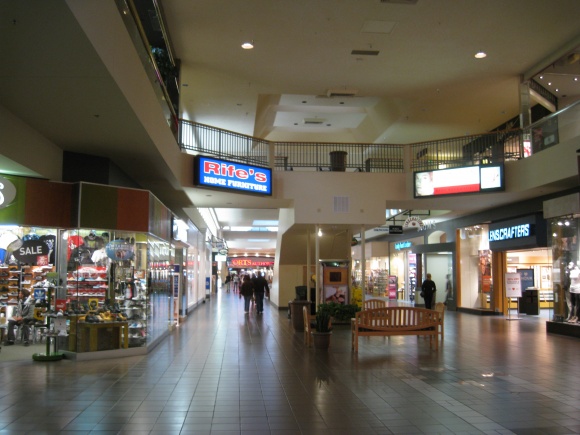 The former Bon Marché/Macy’s wasn’t vacant for long, however. Fresno, Calif.-based Gottschalks came calling, and opened there in 2006. Also in 2006, Copeland’s Sports went out of business and became Sports Authority.
The former Bon Marché/Macy’s wasn’t vacant for long, however. Fresno, Calif.-based Gottschalks came calling, and opened there in 2006. Also in 2006, Copeland’s Sports went out of business and became Sports Authority.
The most recent change to take place at Valley River Center is the departure of Gottschalks in 2009, due to the entire chain’s failure. Whoops, they weren’t there long. Their anchor is still vacant and for lease, so if you know any mall anchors scurrying around looking for a home, that’s where to go.
As of 2010, Valley River Center has held its own against Gateway Mall and the smaller Oakway Center. While Oakway Center is thriving as a mostly outdoor mall with upscale specialty retailers, big box stores, and restaurants, Gateway Mall has fallen on hard times and is currently in major trouble. Valley River Center is the clear, dominant retail center for the Eugene-Springfield area, and is a major regional draw.
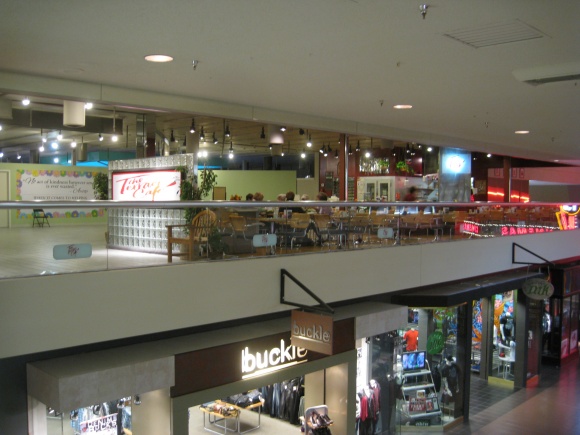 Valley River’s current anchors include Macy’s, charter tenant JCPenney, Sports Authority, and Regal Cinemas. Caldor and I visited the mall for the first time in October 2010 and took the pictures featured here, with the exception of the vintage photo which we stole from Malls of America and the Emporium photo we took from boundless.uoregon.edu.
Valley River’s current anchors include Macy’s, charter tenant JCPenney, Sports Authority, and Regal Cinemas. Caldor and I visited the mall for the first time in October 2010 and took the pictures featured here, with the exception of the vintage photo which we stole from Malls of America and the Emporium photo we took from boundless.uoregon.edu.
We especially liked the mall’s vintage appearance – even after the 2003-04 renovations this mall looks pretty dated compared to many A-level malls we’ve visited recently, and that’s not a bad thing at all. We also appreciated the bonus mezzanine level, which is currently home to some of the last vestiges of parquet flooring on earth, and also houses a 1980s-style restaurant that overlooks the mall called Terrace Cafe, which is a terrific doppelganger for The Max on Saved by the Bell. There’s also a furniture store called Rife’s up there, a hair salon, a DMV center, and an alterations shop up there, too, along a long and desolate corridor. In addition, we really liked the high ceilings and the square windows along each hallway throughout the entire mall, as well as the crazy wig shop in the dark, dreary former Gottschalks wing. This has to give children nightmares:
We really enjoyed Valley River Center. Let us know what you think in the comments.
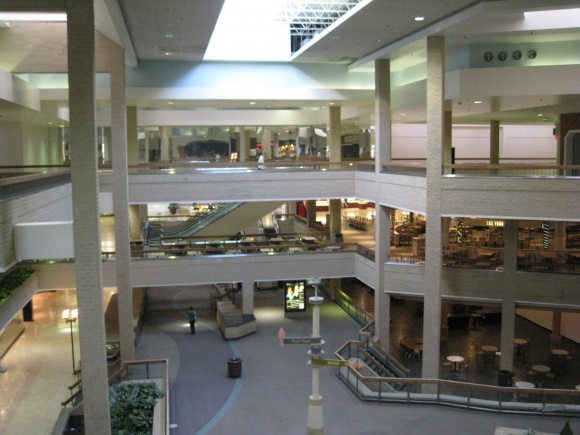 Neatly perched atop a giant slag pile nine miles southeast of downtown Pittsburgh, Century III Mall has an interesting name and an even more interesting history. Opened in 1979, Century III Mall was the result of a mutually beneficial partnership between regional real estate magnate Edward DeBartolo of Youngstown, Ohio, who wanted to build a giant mall, and the U.S. Steel Corporation, who had a giant mountain of slag marring the landscape south of Pittsburgh that needed a better use. For those who don’t know, slag is a by-product of steel production, and for many decades the slag from Pittsburgh’s steel mills was transported to this site until it became an otherworldly artificial mountain taller than anyone could have imagined, disaffectionally known as Brown’s Dump.
Neatly perched atop a giant slag pile nine miles southeast of downtown Pittsburgh, Century III Mall has an interesting name and an even more interesting history. Opened in 1979, Century III Mall was the result of a mutually beneficial partnership between regional real estate magnate Edward DeBartolo of Youngstown, Ohio, who wanted to build a giant mall, and the U.S. Steel Corporation, who had a giant mountain of slag marring the landscape south of Pittsburgh that needed a better use. For those who don’t know, slag is a by-product of steel production, and for many decades the slag from Pittsburgh’s steel mills was transported to this site until it became an otherworldly artificial mountain taller than anyone could have imagined, disaffectionally known as Brown’s Dump.
Neatly perched atop a giant slag pile nine miles southeast of downtown Pittsburgh, Century III Mall has an interesting name and an even more interesting history.
Opened in 1979, Century III Mall was the result of a mutually beneficial partnership between regional real estate magnate Edward DeBartolo of Youngstown, Ohio, who wanted to build a giant mall, and the U.S. Steel Corporation, who had a giant mountain of slag marring the landscape south of Pittsburgh that needed a better use. For those who don’t know, slag is a by-product of steel production, and for many decades the slag from Pittsburgh’s steel mills was transported to this site until it became an otherworldly artificial mountain taller than anyone could have imagined, disaffectionally known as Brown’s Dump.
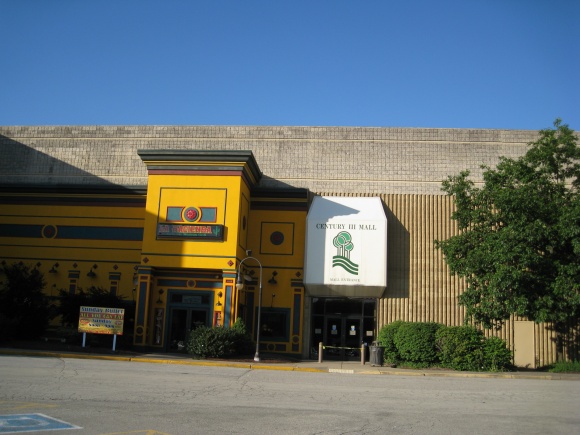 Before Brown’s Dump could be successfully turned into the retail strip consisting of box stores, restaurants, and the Century III Mall that exist there today, the site needed to be carefully remediated. This involved sealing and filling the mines with concrete and the cleaning and leveling of surfaces. One source reported that more concrete was used to seal and fill the mines than was used in the entire mall and all of its adjacent retail structures combined. There are still surviving ladle cars near the mall, remnants of its former land use.
Before Brown’s Dump could be successfully turned into the retail strip consisting of box stores, restaurants, and the Century III Mall that exist there today, the site needed to be carefully remediated. This involved sealing and filling the mines with concrete and the cleaning and leveling of surfaces. One source reported that more concrete was used to seal and fill the mines than was used in the entire mall and all of its adjacent retail structures combined. There are still surviving ladle cars near the mall, remnants of its former land use.
When Century III opened in 1979, it was apparently one of the largest enclosed malls in the world; and, despite its location, squirreled away in the southeast suburbs of Pittsburgh, it immediately became a super-regional draw. Century III’s unique name comes from being completed slightly after America’s 1976 Bicentennial, so it was aptly named for the dawn of America’s third century.
Century III opened in two phases. According to commenter Eric S., Phase I opened in October 1979, with two two-level anchors: Kaufmann’s and JCPenney. The second phase opened in March, 1980, and added a two-level Montgomery Ward. Several months later, in Fall 1980, Sears and Gimbels opened, which were also two level anchors. After the mall was complete, it had 5 two-level anchors and an awesome floorplan. The mall is two levels throughout, with a three-level labyrinth of confusing platforms, connections, wall-sized mirrors and walkways at the Sears end. Architecturally, this end of the mall and the aforementioned features are what makes this mall amazing and unique.
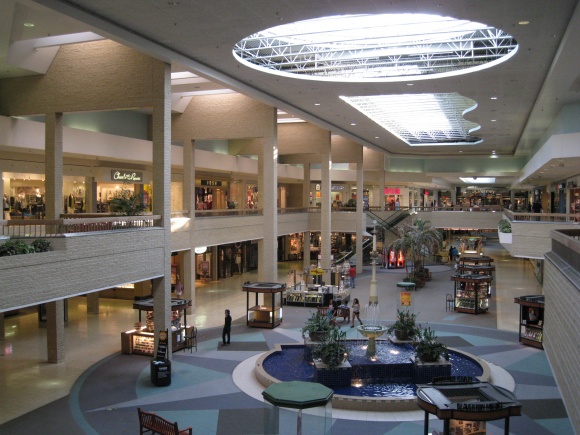 Anchor changes at Century III began in 1986, with the closure of Montgomery Ward. It was replaced right away by Pittsburgh-based Horne’s, and later became Columbus-based Lazarus in 1994. Lazarus pulled out after four short years in 1998, and the anchor became a Kaufmann’s Furniture Gallery, which then became Macy’s Furniture Gallery in 2006 until that closed in January 2009. As of 2010, it’s still sitting vacant.
Anchor changes at Century III began in 1986, with the closure of Montgomery Ward. It was replaced right away by Pittsburgh-based Horne’s, and later became Columbus-based Lazarus in 1994. Lazarus pulled out after four short years in 1998, and the anchor became a Kaufmann’s Furniture Gallery, which then became Macy’s Furniture Gallery in 2006 until that closed in January 2009. As of 2010, it’s still sitting vacant.
The second anchor to switch hands was Gimbels, which closed in January 1988 following the folding of the chain. It sat vacant until 1993, when Marshalls took the upper level, and TJ Maxx took the lower level. This must have been an interesting pairing, because Marshalls and TJ Maxx are both similarly-themed nameplates owned by the same company, TJX. I’ve never seen TJ Maxx and Marshalls so closely co-located, let alone one on top of the other. As explained in the comments, the two stores were owned by different parent companies, so they were indeed different, competing ventures. Still weird, though, like having Linens ‘n Things and Bed Bath and Beyond stacked on top of each other. The pairing didn’t last long, though, because the upper level Marshalls closed in 1996 after Marshalls was sold to TJX. TJ Maxx remained on the lower level until 2003, converting to a TJ Maxx ‘n More in 1998. The upper level, vacated by Marshalls in 1996, eventually became a Wickes Furniture in 1997, which lasted until 2004 when it closed and reopened as Dick’s Sporting Goods. The former TJ Maxx on the lower level became Steve and Barrys in 2003, until Steve and Barry’s went broke in 2009. As of 2010, the lower level anchor remains vacant.
The third anchor change at Century III took place in 2006, with the rebranding of Kaufmann’s to Macy’s. According to mall-hall-of-fame, this anchor was also the only one that was physically expanded, adding 17,000 square feet of retail space in the 1980s.
Both JCPenney and Sears at Century III have remained open since the initial phases of the mall opened in 1979-1980. Mall-hall-of-fame has created a graphic illustrating the anchor changes at Century III here.
More recently, however, Century III entered a slow and steady period of decline, which steepened precipitously following competition from new, nearby developments, even despite a cosmetic renovation of the entire mall in 1996. The Waterfront, an outdoor mall with over 1 million square feet of retail space, including Macy’s and many mid-market mall stores like Abercrombie and Fitch, opened in 1999, and SouthSide Works, an outdoor retail and entertainment district, opened between 2002-2004. Both of these new outdoor developments opened along the south banks of the Monongahela River, just a few miles north of Century III Mall.
Although The Waterfront and SouthSide Works hampered Century III the most among its competition, other regional competitors also came a-callin’ to decimate Century III’s customer base even further. Two brand-new enclosed malls opened in the Pittsburgh area in the 2000s: The Mall at Robinson in Pittsburgh’s western suburbs, in 2001, and Pittsburgh Mills in the northeast suburbs, in 2005. These two malls continue to have a super-regional draw.
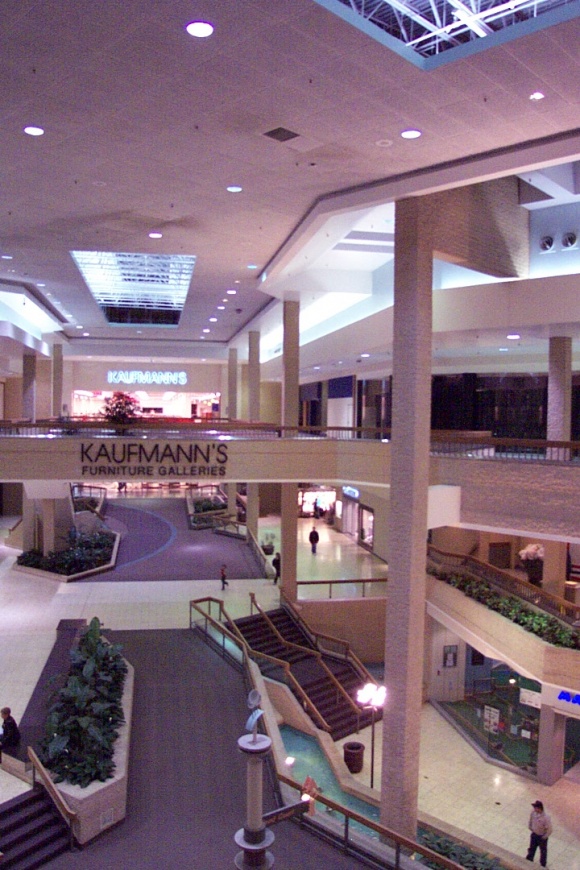 In addition to new malls, the extant malls in the region beefed up their offerings during the same period. North-suburban Ross Park Mall (a fine name for a mall, if I do say so myself) renovated and solidified its hold on that side of the city, eventually wooing Nordstrom. Monroeville Mall did the same for the east side and affluent suburbs like Penn Hills, home of presidential candidate Rick Santorum, and South Hills Village clinched a hold on the US 19 retail corridor south of the city. There’s no shortage of retail east or south of Century III either, as there are malls in both Westmoreland and Washington Counties.
In addition to new malls, the extant malls in the region beefed up their offerings during the same period. North-suburban Ross Park Mall (a fine name for a mall, if I do say so myself) renovated and solidified its hold on that side of the city, eventually wooing Nordstrom. Monroeville Mall did the same for the east side and affluent suburbs like Penn Hills, home of presidential candidate Rick Santorum, and South Hills Village clinched a hold on the US 19 retail corridor south of the city. There’s no shortage of retail east or south of Century III either, as there are malls in both Westmoreland and Washington Counties.
All of these other retail centers are also better positioned to serve Pittsburghers, located either on main highways or near affluent population centers, or both. Anyone who lives or is familiar with the transportation network in the Pittsburgh area knows how difficult getting around the region is, due to intense topography and three large rivers. There are no linear, flat highways anywhere in Pittsburgh, and getting around without a GPS or a sturdy map is a chore.
Successful retail centers in Pittsburgh have either easy access to freeways, like Mall at Robinson, Pittsburgh Mills, and Monroeville Mall, or placement in a dense population area, like The Waterfront and SouthSide Works. Ross Park Mall and South Hills Village aren’t on freeways, but are the centers of relatively affluent population areas, and anchors to massive retail strips along US 19 north and south of downtown. The area around Century III, while on a somewhat major thoroughfare heading southeast from Pittsburgh, is predominantly connected to a region that has seen better days. The Mon River Valley has been on a downward trajectory for almost the entire time the mall has been around, losing both population and jobs due to the exit of the steel industry, and has struggled to stay afloat economically, despite the nascent recovery in other parts of Pittsburgh.
Considering the mall’s most recent troubles, is its name an ominous harbinger of what’s to come for our nation during its third century? Perhaps it is a telling warning against the consumptive over-building of our landscape, and also the state of consumerism in general that Century III, like so many other regional malls, has become a deteriorating pock-mark of failure on the landscape in the third century of America. Or is it, instead, a carefully crafted example of capitalism reflected in the built environment? The site was, after all, recycled from a previous and not-so-nice use, and it had a good run. Maybe it’s time for a different use – but what?
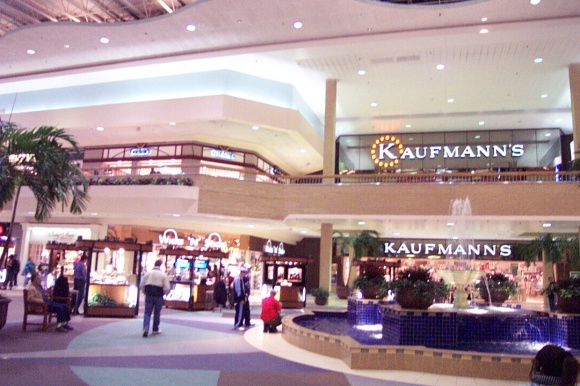 Nobody seems to really know what to do with the site. Furthermore, while on a downward spiral, the mall’s not quite dead enough to seriously begin drafting plans for redevelopment. I imagine, though, that in a few years the breaking point will emerge and Century III will totally fail, unless proactive intervention helps to bolster the mall. I fully expect the former, though, and would be very surprised (yet hopeful) for the latter.
Nobody seems to really know what to do with the site. Furthermore, while on a downward spiral, the mall’s not quite dead enough to seriously begin drafting plans for redevelopment. I imagine, though, that in a few years the breaking point will emerge and Century III will totally fail, unless proactive intervention helps to bolster the mall. I fully expect the former, though, and would be very surprised (yet hopeful) for the latter.
On a more personal note, I love Pittsburgh and feel that it’s one of the most underrated cities in the country. The world class museums, architecture, fine arts, and educational offerings there are on par with many other cities of less ill repute. There’s a heck of a lot to do in Pittsburgh – more than you can wrap your gum bands around. Pittsburgh’s real gems, though, are its neighborhoods. Separated by a rather intense topography, Pittsburgh’s neighborhoods are not only unique and well-defined, but intensely provincial – and people care about them. I love that Pittsburgh is so rooted in place that even the collapse of the entire steel industry didn’t turn it into a Detroit, or even a Cleveland. Sorry, Cleveland, at least you’re not Detroit. Pittsburghers even have their own regional accent and lexicon, independent from everywhere else. Sure, there are parts of the city, and the region, that are no doubt worse for wear, but the city still has so many cultural gems and so many neighborhoods that have walkable districts, unique shops and active street life.
They also have Century III Mall, which is an amazing gem as well if you can appreciate such things as shopping malls, and if you’re reading this blog you probably know what I’m talking about. We visited Century III Mall in March 2004, and again in Summer 2010. Feel free to leave your own anecdotes and reactions on the comments page.
Century III Mall elsewhere on the web:
2004:
2010:
 An unusual characteristic about Frederick is, despite a relatively small size, it is home to two medium-sized shopping malls. Frederick Towne Mall, located on the “Golden Mile” retail strip of U.S. 40 on the west side of town, was the first mall in town, and opened to massive fanfare in 1972. Francis Scott Key Mall, which opened a few years later in 1978, anchors another retail area on the south side of town adjacent to Interstate 70, which goes east to Baltimore, and Interstate 270, which goes south to Montgomery County and Washington, D.C.
An unusual characteristic about Frederick is, despite a relatively small size, it is home to two medium-sized shopping malls. Frederick Towne Mall, located on the “Golden Mile” retail strip of U.S. 40 on the west side of town, was the first mall in town, and opened to massive fanfare in 1972. Francis Scott Key Mall, which opened a few years later in 1978, anchors another retail area on the south side of town adjacent to Interstate 70, which goes east to Baltimore, and Interstate 270, which goes south to Montgomery County and Washington, D.C.
Frederick, Maryland is an outlying anchor city of the Baltimore-Washington Metropolitan Area. Located about 50 miles from both downtown Washington and downtown Baltimore, Frederick is both a commuter exurb and a city in its own right. With a population of about 60,000, Frederick is the third largest incorporated city in Maryland, after Baltimore and Rockville, and is also the gateway to points west from the DC-Baltimore metropolitan area.
An unusual characteristic about Frederick is, despite a relatively small size, it is home to two medium-sized shopping malls. Frederick Towne Mall, located on the “Golden Mile” retail strip of U.S. 40 on the west side of town, was the first mall in town, and opened to massive fanfare in 1972. Francis Scott Key Mall, which opened a few years later in 1978, anchors another retail area on the south side of town adjacent to Interstate 70, which goes east to Baltimore, and Interstate 270, which goes south to Montgomery County and Washington, D.C.
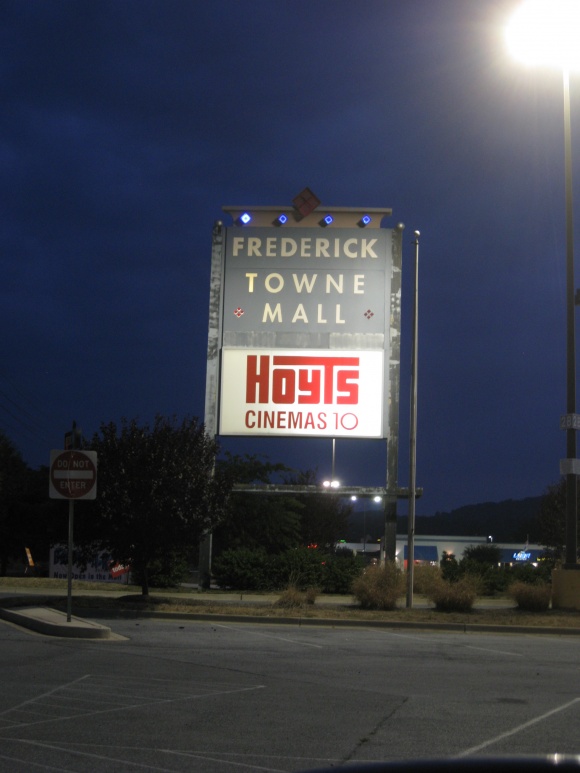 In a classic case of regional retail overload, the Francis Scott Key Mall and its surrounding retail area gradually became the dominant retail area in town, replacing Frederick’s Golden Mile and the Towne Mall that anchors it. Other regional malls were also constructed in the nearby cities of Martinsburg, Hagerstown, Chambersburg, Westminster, as well as in monied Montgomery County, giving residents from nearby places little reason to come to Frederick to do their shopping. In addition, the offerings constructed in Montgomery County and Northern Virginia became a draw for Frederick residents who were seeking a more total and slightly upscale retail experience. As a result, having two malls in Frederick proved to be two too many.
In a classic case of regional retail overload, the Francis Scott Key Mall and its surrounding retail area gradually became the dominant retail area in town, replacing Frederick’s Golden Mile and the Towne Mall that anchors it. Other regional malls were also constructed in the nearby cities of Martinsburg, Hagerstown, Chambersburg, Westminster, as well as in monied Montgomery County, giving residents from nearby places little reason to come to Frederick to do their shopping. In addition, the offerings constructed in Montgomery County and Northern Virginia became a draw for Frederick residents who were seeking a more total and slightly upscale retail experience. As a result, having two malls in Frederick proved to be two too many.
So which mall would Frederick choose to support, and which mall would be thrown in the trash? The answer would be informed by demographic shift, creating crime or the perception thereof, a dash of mother nature, and three cups of competition.
Beginning as early as the late 1970s, and ramping up through the 1990s, the retail dominance in Frederick began to shift from the Golden Mile/Towne Mall area to the area around Francis Scott Key Mall, along MD Highway 85. This was precipitated by a few factors. First, as we mentioned above, the region was saturated with regional malls in nearly every direction, negating the necessity for having two of them in town.
A major shift in local demographics also informed where the dominant retail placement would be. The area around the Golden Mile became home to more and more low income housing, and after a series of events, earned a reputation for crime. Violent crime surrounded the area of Towne Mall, and frequent fights began to break out in the mall itself. These events became well publicized in the media, and locals began reallocating their dollars to the safer retail district across town, near Francis Scott Key Mall.
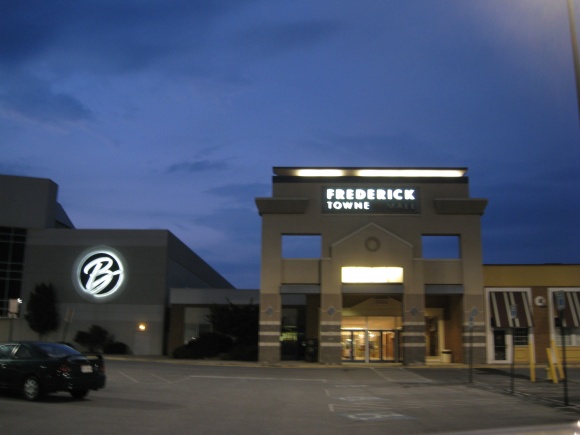 Mother nature played a role, too. The creek behind the mall is prone to flooding, and a significant portion of the mall is within the 100-year floodplain. This makes it tough for anyone who wants to ameliorate the decline of the area, because FEMA has very specific and complicated rules about development in the floodplain, even prohibiting renovations on existing structures.
Mother nature played a role, too. The creek behind the mall is prone to flooding, and a significant portion of the mall is within the 100-year floodplain. This makes it tough for anyone who wants to ameliorate the decline of the area, because FEMA has very specific and complicated rules about development in the floodplain, even prohibiting renovations on existing structures.
Topography is also a major factor that has limited new development along the Golden Mile. Because of large hills on either side of U.S. 40, development is limited to a short space along the highway corridor, and most of the corridor is already built out.
In response to these challenges on the Golden Mile, developers chose to build a new retail corridor, centered around Francis Scott Key Mall across town. The new retail corridor would not have any of these challenges, and would have access from both interstates 70 and 270.
In 2001, Montgomery Ward closed their doors nationwide, including their store at Towne Mall. It was eventually replaced by a Home Depot in 2004, which does not have mall access.
The next store to defect from Towne Mall was JCPenney, which moved to FSK Mall in the early 2000s. It wasn’t a terrible blow, however, because the space was swiftly replaced by Boscov’s in October 2003.
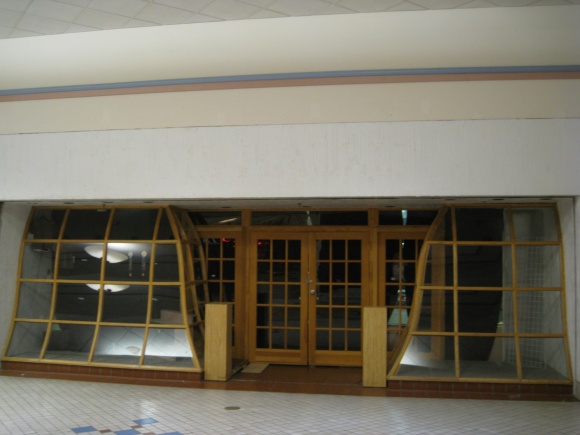 Despite retaining three anchors throughout most of its history, the interior of Towne Mall has suffered the most over the past decade. Longtime tenants like Chanticleer Shoes, Gentlemans Choice, Long John Silvers, and others have either closed or relocated, leaving the interior corridor of the mall awash with dead stores and few patrons. The few stores left cater mostly to either a low income or specialty niche, with several dollar stores and even a dead store converted to a bouncy castle. The Radio Shack in the mall, which was still open as of August 2010, said that 75 percent of their business was providing cell phones to hispanic customers.
Despite retaining three anchors throughout most of its history, the interior of Towne Mall has suffered the most over the past decade. Longtime tenants like Chanticleer Shoes, Gentlemans Choice, Long John Silvers, and others have either closed or relocated, leaving the interior corridor of the mall awash with dead stores and few patrons. The few stores left cater mostly to either a low income or specialty niche, with several dollar stores and even a dead store converted to a bouncy castle. The Radio Shack in the mall, which was still open as of August 2010, said that 75 percent of their business was providing cell phones to hispanic customers.
After all the problems, mall owners were quick to react to the situation, and put together plans to renovate the mall into a mixed-use lifestyle center in 2005. The plan was approved in 2006, and included a new parking deck to the north of the Bon Ton anchor, a line of residential condos, space for new outparcels, and a total remodeling of the mall, demolishing the interior corridors and replacing them with outdoor ones.
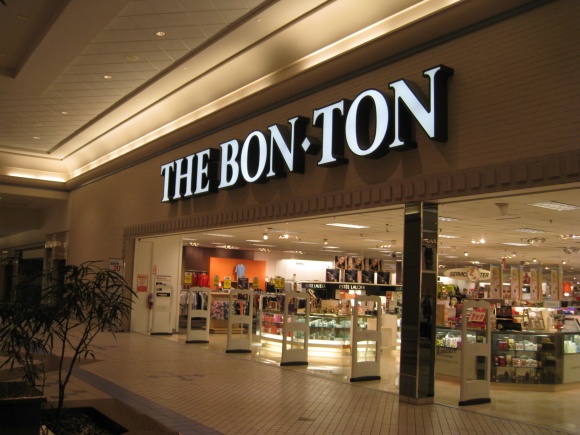 However, a few years went by, and murmurs about redevelopment were quieted due to the economy, lack of intered from leasing parties, and the inability to secure credit to build the project. In 2009, the local paper revealed that a new developer was on board, and that plans may have changed. A spokesman for the developer, DLC Management, said that they were evaluating and formulating their plan in 2009, and as of 2010 had not brought forth anything concrete. Reading in between the lines, it looks like nothing is going to happen here until the place either falls down or closes permanently and becomes a blighted eyesore, “requiring” more financial assistance from the government to be redeveloped. DLC’s page on Frederick Towne Mall links to a storetrax profile which provides absolutely no clues either.
However, a few years went by, and murmurs about redevelopment were quieted due to the economy, lack of intered from leasing parties, and the inability to secure credit to build the project. In 2009, the local paper revealed that a new developer was on board, and that plans may have changed. A spokesman for the developer, DLC Management, said that they were evaluating and formulating their plan in 2009, and as of 2010 had not brought forth anything concrete. Reading in between the lines, it looks like nothing is going to happen here until the place either falls down or closes permanently and becomes a blighted eyesore, “requiring” more financial assistance from the government to be redeveloped. DLC’s page on Frederick Towne Mall links to a storetrax profile which provides absolutely no clues either.
We visited Frederick Towne Mall in March 2004 and again in August 2010. The difference between those two periods is stark, as the mall was only beginning to show vacancies in 2004 and in 2010 is on life support. In 2010, the security guard didn’t even have much to do, he was just sitting near the Boscov’s anchor looking bored.
March 2004:
August 2010: